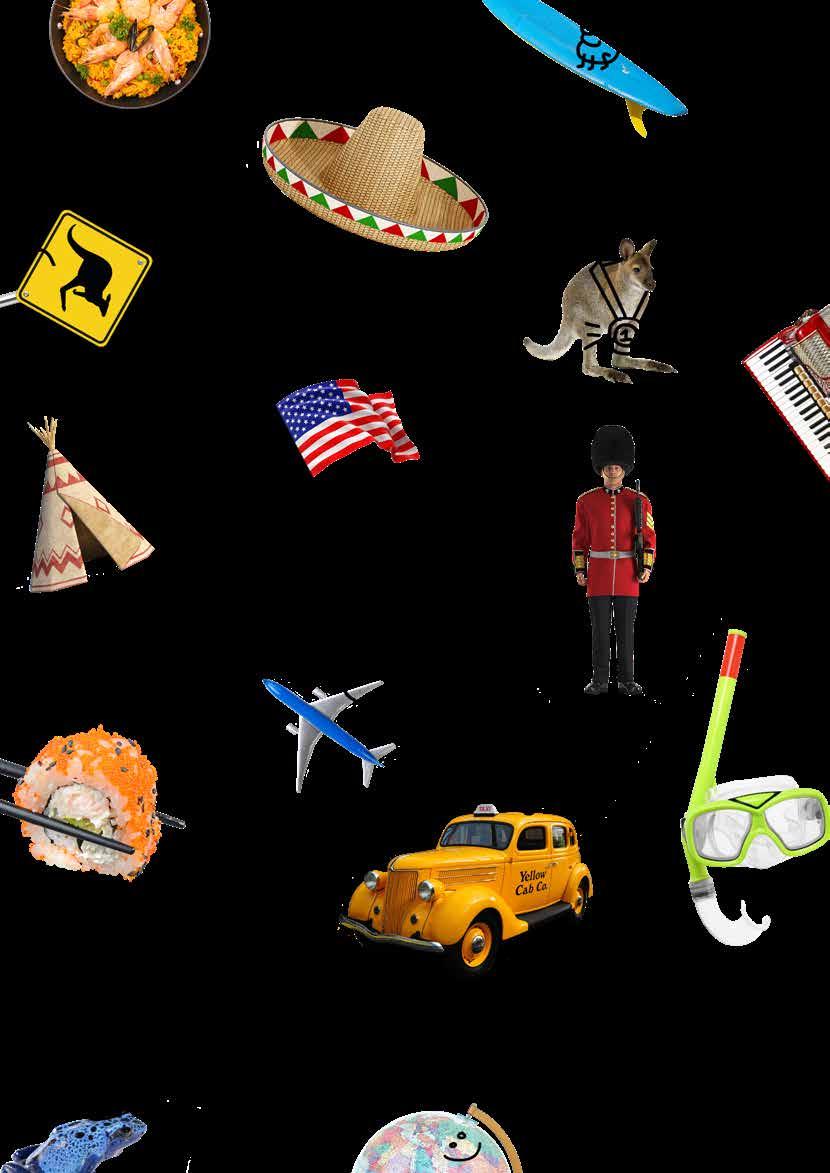De proeflessen, lesbeschrijvingen en de antwoorden kun je ook gratis downloaden op; www.thiememeulenhoff.nl/takeiteasy/proeflessen



De proeflessen, lesbeschrijvingen en de antwoorden kun je ook gratis downloaden op; www.thiememeulenhoff.nl/takeiteasy/proeflessen


De proeflessen, lesbeschrijvingen en de antwoorden kun je ook gratis downloaden op; www.thiememeulenhoff.nl/takeiteasy/proeflessen
LESBESCHRIJVINGEN
De proeflessen, lesbeschrijvingen en de antwoorden kun je ook gratis downloaden op; www.thiememeulenhoff.nl/takeiteasy/proeflessen


Lesdoelen les 1
Aan het eind van de les kunnen de leerlingen: • informatie over dieren halen uit de film, het lied en de dialoog, en vragen daarover beantwoorden.
Aan het eind van de les kennen de leerlingen: • de leswoorden: bird, blue, black, green, grey, orange, pet, puppy, red, white
Benodigde materialen:
• introductieopdracht: vier grote vellen papier, kopieerblad 3.01, schaar, lijm en kleurpotloden; • opdracht 6: kopieerblad 3.02; • ster-opdracht 1: kopieerblad 3.03.
Introductie les 1 (10 min)
Kies in het lesmenu welke onderdelen passen bij jouw groep.
Introductieopdracht – opdracht 1 verwerken
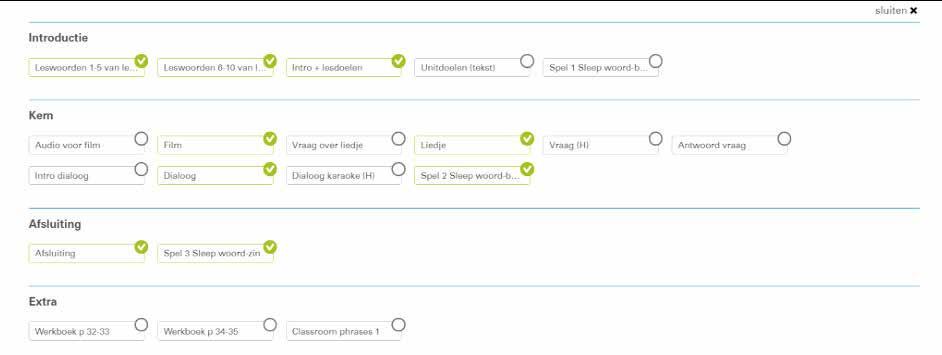
Neem vier vellen papier en teken op elk vel een woordspin. Schrijf in het midden van iedere woordspin één van de volgende kleuren: black, grey, green en white. De woorden schrijf je in hun eigen kleur. De kleur white maak je duidelijk door de contouren van de letters met zwart te tekenen en het wit er binnenin te benadrukken. Om de woordspin heen teken je een aantal vakjes. De leerlingen noemen om de beurt een dier dat die betreffende kleur heeft. Dat mag in het Engels of in het Nederlands. Deel daarna kopieerblad 3.01 uit. Per tafelgroepje knippen de leerlingen de dieren uit en kleuren ze in hun goede kleur. Hebben de dieren kleuren die in de woordspinnen voorkomen? Dan plakken de leerlingen om de beurt een dier op een vakje van de woordspin met de juiste kleur. Herhaal telkens het Engelse woord voor de kleur. Er mogen er ook meer kleuren worden benoemd: het konijn kan bijvoorbeeld wit, grijs of zwart zijn, maar heeft een oranje (orange) wortel. Je kunt ook kleuren benoemen die in deze les nog niet aan de orde komen.
De leerlingen maken tijdens het verwerken de opdrachten 2 t/m 6. Na het bekijken van de film maken ze opdracht 2 en 3, gevolgd door opdracht 4 na het lied. Opdracht 5 en 6 maken de leerlingen na de dialoog.
Vertalingen van vragen en antwoorden: Engels Nederlands
Audio Let’s watch the film. The film is about two children and some animals. The children talk about their favourite animals.
Vraag Can you guess what pet I like? It is yellow and blue. It can fly. It can talk. What is it?
We gaan film kijken. Deze gaat over 2 kinderen en een paar dieren. De kinderen praten over hun lievelingsdier.
Kun jij raden van welk huisdier ik houd? Het is geel en blauw. Het kan vliegen. Het kan praten. Wat is het?
Antwoord Yes. It’s a parrot. Ja, het is een papegaai.
Lied
Vraag What does the horse say? Which animal did you also see? What colour is the rabbit?

Antwoord
The horse says: hiiiii. You also see a cat. The rabbit is brown.
Extra uitleg bij opdracht 5 en opdracht 6
Wat zegt het paard? Welk dier zie je nog meer? Welke kleur heeft het konijn?

Het paard zegt: hiiii. Je ziet ook een kat. Het konijn is bruin.
Opdracht 5: de leerlingen herhalen de dialoog en oefenen hoe ze eenzelfde soort gesprek kunnen voeren. De vraag Have you got any pets? en het antwoord Yes, I have a … of No, I have not (of; No, I haven’t), staan hierbij centraal.
Opdracht 6: de leerlingen gebruiken kopieerblad 3.02 en vouwen het vouwspelletje volgens de instructies. Daarna gaan ze aan de slag met de opdracht ‘A blue cow’. Eerst noemen ze een getal, waarna een dier volgt, gevolgd door nog een getal, waarna een kleur volgt. De leerlingen oefenen hiermee hun Engelse dieren- en kleurenkennis.
Bij ster-opdracht 1 gebruiken de leerlingen kopieerblad 3.03 en geven daarbij de papegaai de juiste kleuren die in het Engels staan aangegeven.
Bij ster-opdracht 2 vullen de leerlingen een dierenpaspoort in, waarbij ze informatie over hun eigen of een fantasiehuisdier geven.
Afsluiting les 1 (10 min)
Na het verwerken, volgt de afsluitende opdracht.
Alle leerlingen gaan staan. Zeg voorafgaand aan de opdracht dat de leerlingen de kleuren die je straks noemt, moeten onthouden. Of schrijf de kleuren op het digibord. Bedenk welke kleuren je gaat zeggen in het Engels en baseer die op de kleding die je in de klas ziet. Noem nu een kleur. Leerlingen die deze kleur niet in hun kleding dragen, moeten gaan zitten. De andere leerlingen blijven staan. Vervolgens noem je een andere kleur. Het doel van het spel is om zo lang mogelijk te blijven staan en goed in de kleding naar bepaalde kleuren te zoeken. Speel het spel voor een tweede keer. Als het goed is, hebben de leerlingen de kleuren onthouden. Geef de leerlingen, voordat je aan het tweede spel begint, de mogelijkheid om kleding te ruilen of om jassen aan te trekken. Blijven er nu meer leerlingen staan?
AantekeningenLesdoelen les 2
Aan het eind van de les kunnen de leerlingen:
• informatie over dieren en kleuren halen uit de film, dialoog en het lied, en vragen daarover beantwoorden;
• meezingen met een lied over dieren.
Aan het eind van de les kennen de leerlingen:
• de leswoorden: dog, brown, cat, chicken, cow, horse, pet shop, pig, rabbit, yellow
Benodigde materialen:
• ster-opdracht 2: kopieerblad 3.04;
• afsluiting les: kopieerblad 3.13.
Introductie les 2 (10 min)
Kies in het lesmenu welke onderdelen passen bij jouw groep.
Introductieopdracht – opdracht 1 verwerken
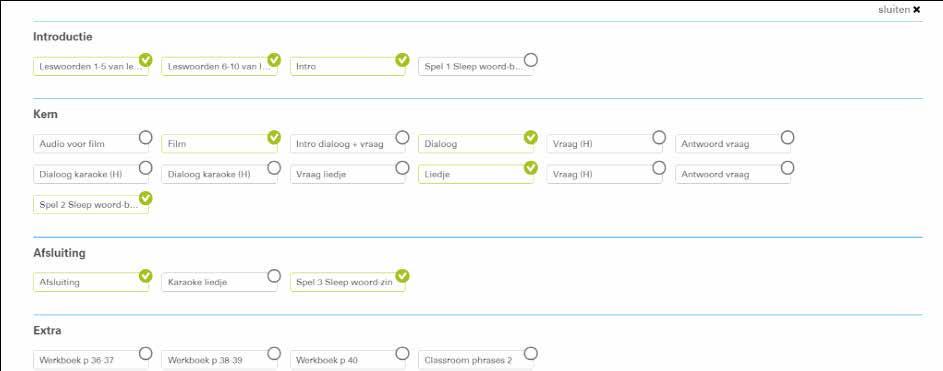
Je speelt Pictionary met dieren. Je tekent een dier op het digibord en de leerlingen raden tijdens het tekenen welk dier het is. Speel het spel eerst in het Nederlands. Zeg, als het dier is geraden, hoe het dier in het Engels heet en vertel welke kleur het dier heeft en hoe je die kleur in het Engels noemt. Speel het spel daarna helemaal in het Engels. Kies om te beginnen dieren uit die in les 1 en 2 aan bod komen: dog, puppy, bird, cat, chicken, cow, horse, pig, rabbit. Je kunt eventueel uitbreiden met de dieren uit les 3: duck, elephant, giraffe, lion, monkey, parrot, snake, tiger. Na het spel maken de leerlingen aanvullend de woordenschatopdracht die bij opdracht 1 hoort.
Introductiefilmpje op digibord: de co-teacher speelt in het introductiefilmpje een kort spel (‘pet or not a pet?’) met de leerlingen.
De leerlingen maken tijdens het verwerken de opdrachten 2 t/m 7. Hierbij kijken en luisteren ze nogmaals naar de film en het lied uit les 1. Opdracht 2 en 3 hebben betrekking op de film. Naar aanleiding van de dialoog maken de leerlingen opdracht 4, 5 en 6. Opdracht 7 volgt na het lied. In les 2 is dit lied voorzien van ondertiteling, zodat je met de leerlingen kunt meezingen (zie ook kopieerblad 3.13).
Audio
Kies het juiste antwoord.
Kies de goede woordspin bij elk dier.
Kruis aan welke dieren je hebt gehoord in het
Let's look at the film again.
Vraag What animal do you like more? Raise your hand if you like cats more than dogs.
Antwoord I see, there are [more / a few] children that like cats better than dogs. Let’s count!

Vraag Which pet does Henry buy?
Bekijk de film opnieuw.
Welk dier vind jij leuker? Steek je hand op als je katten leuker vindt dan honden.
Ik zie dat (meer/ een paar) kinderen katten leuker vinden honden. Laten we tellen!
Welk huisdier koopt Henry?

Antwoord Henry buys a rabbit. Hij koopt een konijn.
Lied
Vraag Which animals do you hear?
Antwoord You can hear: a pig, a cow, a rabbit, a cat, a chicken, a horse, a dog and a duck.
Welke dieren hoor je?
Je hoort: een varken, een koe, een kat, een kip, een paard, een hond en een eend.
Extra uitleg bij opdracht 6 Je laat een aantal dieren op het digibord zien via het internet. Na elk dier dat je laat zien, schrijven de leerlingen de naam van het dier in het Nederlands of Engels op bij de juiste woordspin. Ze vragen zich af: ‘is dit dier een huisdier?’ of ‘is het geen huisdier?’ Doe het eerste dier aan de leerlingen voor. Daarna kijk je de opdracht gezamenlijk na.
Vraag en antwoord bij het lied
Vraag: Which animals do you hear?
Antwoord: You can hear: a pig, a cow, a rabbit, a cat, a chicken, a horse, a dog and a duck.
Bij ster-opdracht 1 testen de leerlingen hun Engelse dierenkennis. Bij ster-opdracht 2 tekenen de leerlingen hun eigen fantasiebeest. Hiervoor gebruiken ze kopieerblad 3.04.
Na het verwerken, kun je als afsluiting het lied nogmaals met de leerlingen zingen. Gebruik kopieerblad 3.13 als je de songtekst op papier wilt hebben.
AantekeningenAan het eind van de les kunnen de leerlingen:
• de /g/ goed uitspreken; • dialogen naspreken en soortgelijke gesprekken in tweetallen voeren.
Aan het eind van de les kennen de leerlingen: • de leswoorden: animal, duck, elephant, giraffe, lion, monkey, parrot, snake, tiger, zoo
Benodigde materialen:
• ster-opdracht 1: een groot vel papier, lijm, schaar, tijdschriften met plaatjes van dieren / mensen / objecten.
Introductie les 3 (10 min)
Kies in het lesmenu welke onderdelen passen bij jouw groep.
Introductieopdracht
De leerlingen zeggen bij opdracht 1 de chant na over de olifant. In de chant wordt de uitspraak van de Engelse /g/ in go aan de orde gesteld. Tijdens de film wijzen de leerlingen met hun vinger naar het digibord als ze de /g/ horen. Ze wijzen bij de woorden: go, grey, big, en nogmaals big. Om deze klank uitgebreider te oefenen, noem je een aantal Engelse woorden waar die klank in voorkomt, zoals green, good, great, begin en again. Wanneer horen de leerlingen de /g/? Ze klappen bij die klank in hun handen.
Kern les 3 (30 min)
De leerlingen maken tijdens het verwerken de opdrachten 2 t/m 6. Na het beluisteren van de dialoog volgen opdracht 2, 3 en 4. Na de cartoon volgt opdracht 5. De laatste opdracht 6 is een TPR-oefening waarbij je het digibord nodig hebt.
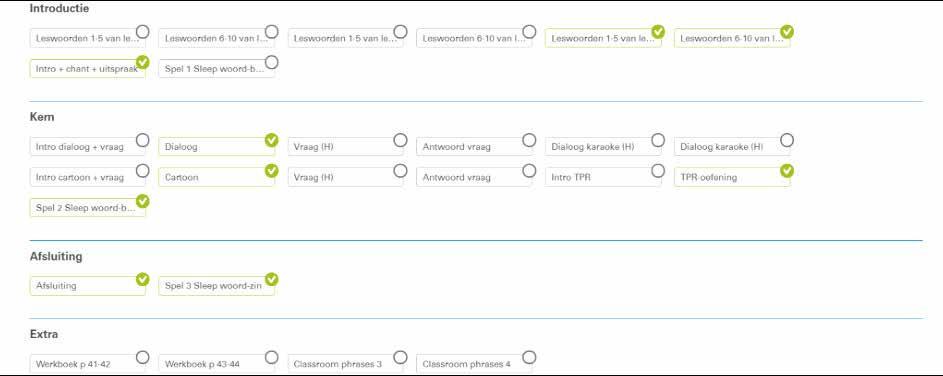
6. Kijk en luister naar Lenny. 5. Kies het juiste antwoord.
*1. Knip en plak verschillende dieren op een papier en praat erover, in tweetallen. *1. Kies een dier en schrijf op wat je erover weet of wat je hebt gevonden aan informatie.
Vraag Can the monkey read?
Kan de aap lezen?
Antwoord No, the monkey can’t read. Nee, de aap kan niet lezen.
Vraag Who is stupid: the parrot or the penguin? Wie is dom: de papegaai of de penguin?
Antwoord Hmm, I don’t know. Maybe they are both a bit stupid. What do you think?

Hmm, ik weet het niet. Misschien zijn ze allebei een beetje dom. Wat denk jij?
De leerlingen stellen elkaar vragen over verschillende eigenschappen van dieren. De ene leerling kiest een dier uit de opdracht en stelt de vragen Can it fly?, Can it sing?, Can it read? of Can it talk? De andere leerling antwoordt hier bevestigend met Yes it can of ontkennend met No it can’t op.
De co-teacher beeldt verschillende dieren uit en de leerlingen doen het na.
Bij ster-opdracht 1 maken de leerlingen hun eigen dieren-zoekplaat. Ze knippen plaatjes uit van verschillende dieren, maar ook van andere objecten: bijvoorbeeld huizen, mensen of planten. Ze plakken al hun plaatjes door elkaar op een groot vel papier en vragen in het Engels aan een klasgenoot om een dier te zoeken tussen alle plaatjes. Vragen als Where did I put the [cow]? en antwoorden die een plaats aanwijzen als: Between two houses, staan centraal.
Bij ster-opdracht 2 zoeken de leerlingen gericht informatie op over een giraf, tijger of een leeuw en proberen dat in het Engels op te schrijven. De informatie kunnen de leerlingen van het internet halen.
Na het verwerken, volgt de afsluitende opdracht.
Per tafelgroepje spelen de leerlingen de TPR-oefening nog een keer. Eén van de leerlingen geeft de anderen opdracht om te doen als een bepaald dier. De anderen voeren de opdracht uit. De leerlingen kunnen de opdracht in het Nederlands geven, maar belangrijk is wel dat het dier in het Engels nogmaals genoemd wordt. Daarna is een andere leerling aan de beurt om de opdracht te geven. Je kunt dit spel ook klassikaal (voor)doen, waarbij een leerling de hele klas de opdracht geeft.
Extra: de voorbereidingen op unit 4
Bij de introductieopdracht in de volgende les (unit 4 – les 1) gebruik je een woordspin of -paraplu die je onder de ABC-knop op het digibord vindt. Schrijf alvast de meest eenvoudige Engelse begrippen met betrekking tot het thema ‘de weg vragen’ in de woordspin/woordparaplu: left, right, straight on (links, rechts en rechtdoor).
De proeflessen, lesbeschrijvingen en de antwoorden kun je ook gratis downloaden op; www.thiememeulenhoff.nl/takeiteasy/proeflessen


1. Make a word web.
Colour the animals. Cut them out. Stick them in the right place.
2. What colour is the cat’s fur in the film?
Circle the right answer.
a. brown b. black c. yellow d. blue
3. Charlie likes parrots. What colour is the parrot in the film?

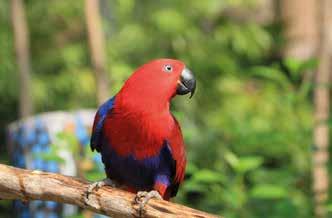
Circle the right answer.
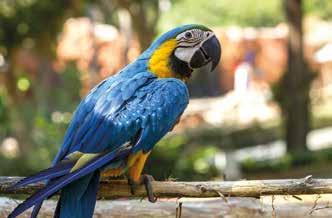
4. Listen to the song.
Tick the right answers.
What does the horse say?
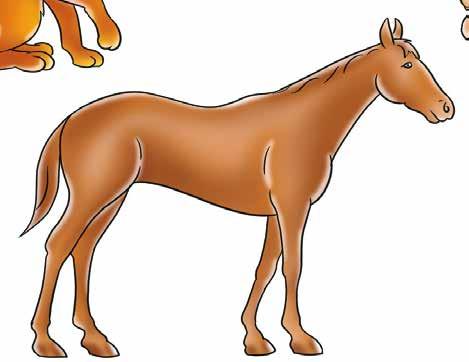
O grrrrr
O hííííííí
O woof
Which animal did you also see?
O mouse
O cat O lion
What colour is the rabbit?
O white O black
O brown
5. Do the dialogue.
Repeat the text with a classmate.
Mr Frost: Have you got any pets?
Gini: Yes, I have a bird.
Mr Frost: Can it talk?
Gini: Yes, it can. It is a parrot.
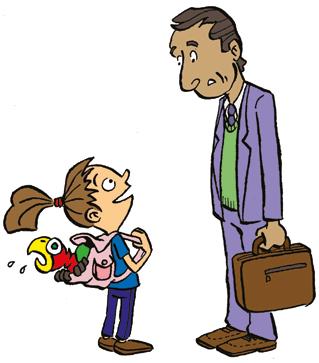
Now ask your classmate: Have you got any pets?
Answer: Yes, I have a ... or No, I have not.
6. Play the game.
For example:


What number do you like? I like number 5. A B
A: What number do you like?
B: I like number 5.
A: 1 – 2 – 3 – 4 – 5. Which one do you choose? B: That one!
A: OK. You chose ‘cow’. What number do you like?
B: I like number 3.
A: 1 – 2 – 3. Which one do you choose? B: That one!
A: OK. You chose ‘blue’. So your favourite animal is a blue cow. Now it is your turn!
Finished? Do this.
You get a picture from your teacher. Look at the numbers. Colour each piece the right colour. What pet do you see? It is a
Finished? Be creative.
Fill in the passport.

1. Play a game.
Your teacher will draw an animal. Can you see what it is? Draw lines to match the words to the pictures. cat




chicken

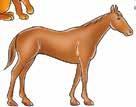
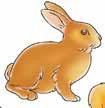
cow dog
horse

rabbit
puppy
pig
2. Watch the film.
Which number is correct?
1. I like frogs.
2. I love my bird. 3. Look, there is a nest. 4. I want to be a parrot.
3. True or false? Circle the right letter.
With these letters you can form a word. Which word?
1. Susie and Charlie hear a cat. D C
2. There is a cat in the tree. A O
3. The name of the cat is Kate. T G
The word is:
4. Listen to the dialogue.
Which pet does Henry buy?
Tick the right answer.
O a cat
O a horse
O a rabbit
O a dog
5. Do the dialogue.
Repeat the text with a classmate.
Shop assistant: Have you got any pets?
Henny: No, I have not. I want to buy a rabbit.
Shop assistant: Brown, black or white?
Henny: Hmm, I do not know. Are they sweet?
Shop assistant: Long ears or short ears?
Henny: Hmm, long ears?
Shop assistant: Here you are. That is five pounds.
Henny: Oh!!!
6. Look and choose.
Fill in the Dutch or English name. Choose the right word web. pet not a pet
7.
Which animals did you hear?
Tick at least three animals.
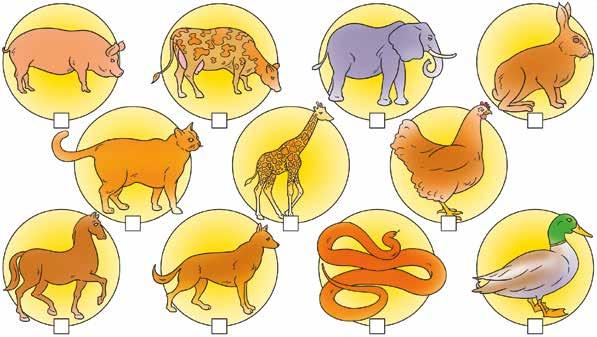
Finished? Do this.
Which animals do you see?
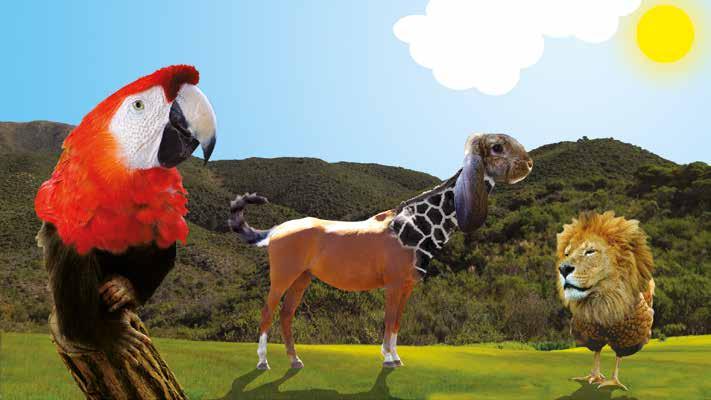
Write them down under the pictures.
Finished? Be creative.
Your teacher will give you a piece of paper. Draw a fantasy animal.
1. Listen and repeat.
Right foot, left foot, see me go, I am grey and big and slow. I come walking down the street, with my trunk and four big feet.
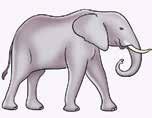
2. Listen to the dialogue.


Can the monkey read?
Circle the right answer.
Yes, he can. / No, he can’t.

3. Do the dialogue.
Repeat the text with a classmate.
Ben: I can see a monkey. Does he have a name?
Zookeeper: Yes, his name is Ben.
Ben: Hey, my name is Ben too! Wow, can he talk?
Zookeeper: Yes, he can talk. Look, he has a newspaper!
Ben: Can he read?
Zookeeper: No, he can’t read.
Ben: Oh. Hey, where is my music player?
Zookeeper: But he can sing!
4. Guess the animal.


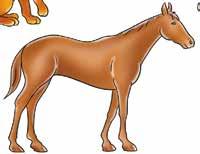
Ask each other what these animals can do.
Choose from these animals:
Choose from these questions:
Choose from these answers:
Can it fly? Yes, it can.
Can it sing? No, it can’t.
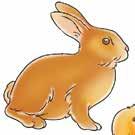
Can it read? Can it talk?
For example: I see a rabbit! Can it read? No, it can’t.
5. Watch the cartoon.
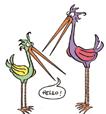

Who is stupid: the parrot or the penguin?

What do you think?
Tick the right answer.

O the parrot O the penguin
O
both: the parrot and the penguin
6. Look and listen.
Finished? Do this.
Cut out pictures of animals whose names you can say in English. Stick them on a piece of paper in between pictures of other things.
Finished? Ask a classmate to find your animals. You can ask: Where did I put the cow? The answer can be: Between the two houses. But remember: only speak English!
Finished? Find out. Choose an animal. Look for information about that animal. Write it down in English! Is it too difficult? Then write in Dutch. Photo: Name: Food: Countries: Colour: Extra information:

Photo: Name: Food: Countries in: Colour: Extra information:
Photo: Name: Food: Countries in: Colour: Extra information:


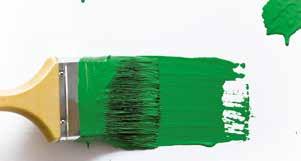
animal dier bird vogel black zwart blue blauw brown bruin cat kat, poes chicken kip cow koe dog hond duck eend elephant olifant giraffe giraf green groen grey grijs horse paard
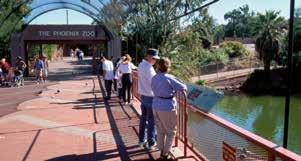

lion leeuw monkey aap orange oranje parrot papegaai pet huisdier pet shop dierenwinkel pig varken puppy puppy, jonge hond rabbit konijn red rood snake slang tiger tijger white wit yellow geel zoo dierentuin
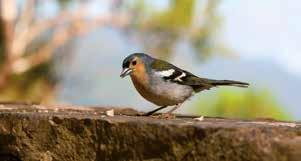
De proeflessen, lesbeschrijvingen en de antwoorden kun je ook gratis downloaden op; www.thiememeulenhoff.nl/takeiteasy/proeflessen
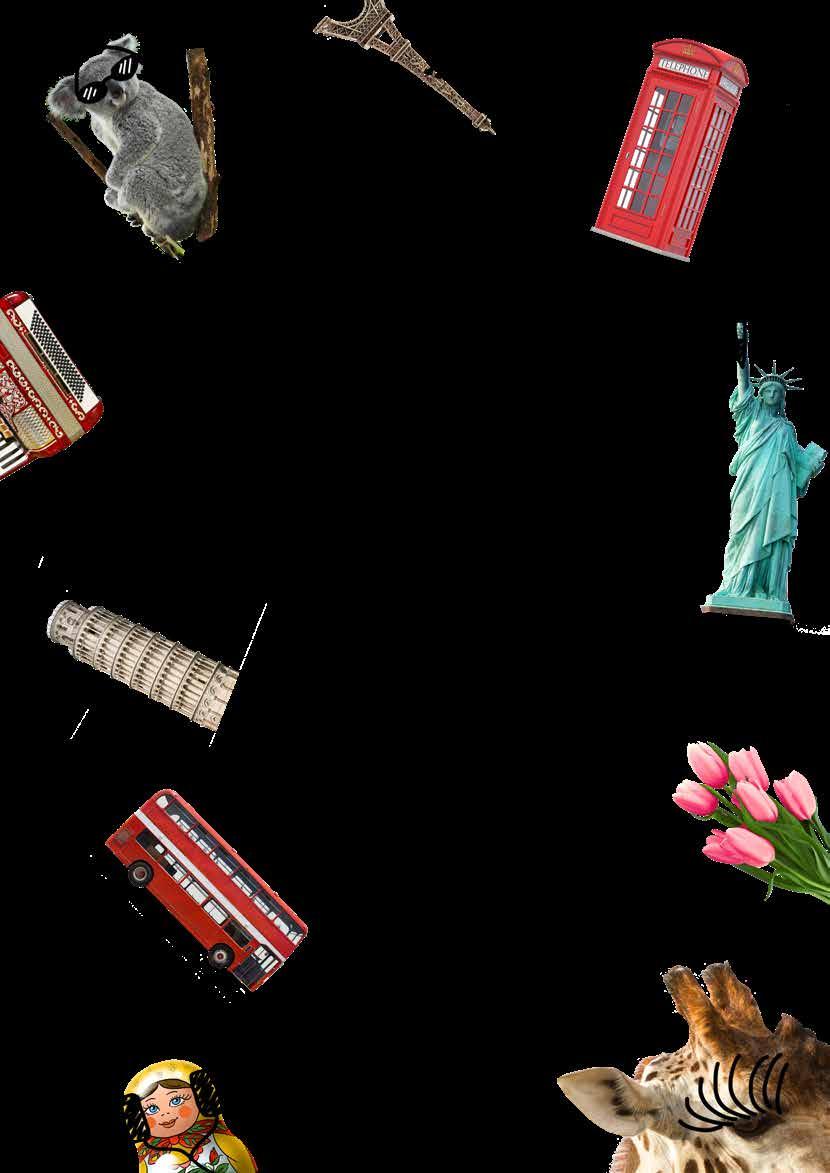

Lesdoelen les 1
Aan het eind van de les kunnen de leerlingen: • informatie over de tijd halen uit de film en het lied, en vragen daarover beantwoorden; • een korte dialoog naspreken over het vragen naar de tijd; • in een kort gesprek, met gegeven zinnen, vragen hoe laat het is, en op een soortgelijke vraag antwoord geven.
Aan het eind van de les kennen de leerlingen: • de leswoorden: the time, a day, a week, Monday, Tuesday, Wednesday, Thursday, Friday, Saturday, Sunday; • het gebruik van zinnen als: What time is it,? It is one o’clock en Yes I do en No, I don’t
Benodigde materialen:
• afsluitende opdracht: de woorden van de introductieopdracht, kopieerblad 3.01, schaar, schrijfmateriaal.
Introductie les 1 (10 min)
Kies in het lesmenu welke onderdelen passen bij jouw groep.
Introductieopdracht – opdracht 1 verwerken
Verzamel met de klas Engelse zinnen en woorden over de tijd op het digibord. Bespreek de woorden en hun betekenis. Welke woorden zijn nieuw voor (een groot aantal van) de leerlingen en welke woorden zijn bij (vrijwel) iedereen bekend? Sla de groep nieuwe woorden op. De leerlingen maken vervolgens opdracht 1 waarbij ze de woorden opschrijven die met tijd te maken hebben.
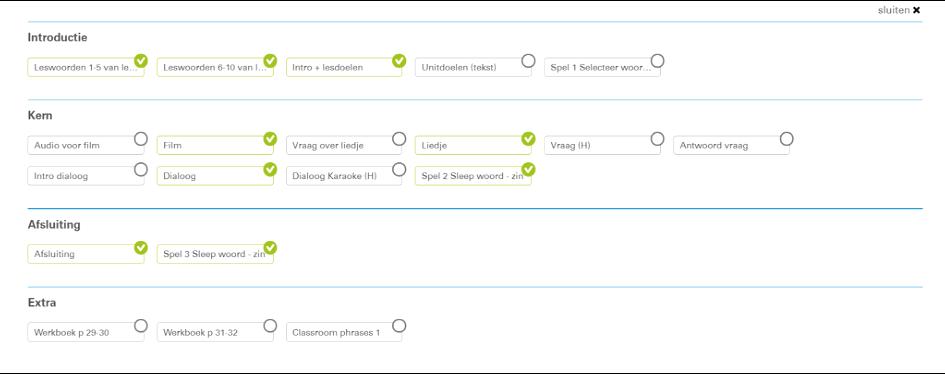
Kern les 1 (30 min)
De leerlingen maken tijdens het verwerken de opdrachten 2 t/m 6. Na het bekijken van de film maken ze opdracht 2 en 3, gevolgd door opdracht 4 na het lied. Opdracht 5 en 6 maken de leerlingen na de dialoog.
Audio Let’s watch the film. The film is about two children doing their homework. They are in a hurry to finish so that they can play a game.
We gaan film kijken. Deze gaat over twee kinderen die hun huiswerk maken. Ze willen het zo snel mogelijk afmaken, zodat ze een spel kunnen spelen.

Vraag Today is Monday. What day was the day before yesterday? Vandaag is het maandag. Welke dag was het eergisteren?

Antwoord
Lied
Vraag
Yes, let’s check. Monday, Sunday, Saturday. That’s it. Saturday.
Which days of the week can you hear in the song?
Antwoord Saturday and Sunday are the days that you hear in the song.
Extra uitleg bij opdracht 5
Ja, laten we het checken. Maandag, zondag, zaterdag. Het is zaterdag.
Welke dagen hoor je in het liedje?
Je hoort zaterdag en zondag in het liedje.
Je legt uit hoe je in het Engels vraagt hoe laat het is (What time is it?) en wat het antwoord daarop kan zijn (It is eight o’clock.). Vervolgens herhalen de leerlingen de dialoog en oefenen hoe ze eenzelfde soort gesprek kunnen voeren. Ze kunnen daarbij zelf de tijd en de plek waar ze heen moeten kiezen.
Bij ster-opdracht 1 maken de leerlingen een puzzel waarbij ze Engelse woorden wegstrepen. Bij ster-opdracht 2 moeten de leerlingen aan de hand van aanwijzingen in het Engels, uitvinden op welke datum de mensen in de opdracht jarig zijn.
Afsluiting les 1 (10 min)
Na het verwerken volgt de afsluitende opdracht.
De leerlingen gaan in groepjes memory spelen. Laat de leerlingen eerst de Engelse woorden over tijd uit de introductieopdracht in tweevoud op de kaartjes van kopieerblad 3.01 schrijven. Deze knippen ze vervolgens uit. Laat de leerlingen nu in hun groepje het spel spelen. Ze husselen de kaartjes door elkaar en keren ze om. De leerlingen mogen steeds om de beurt twee kaartjes omdraaien. Als de kaartjes hetzelfde woord bevatten, mogen ze de kaartjes pakken en twee nieuwe kaartjes omdraaien, anders gaat de beurt naar de volgende leerling. Wie krijgt de meeste kaartjes?
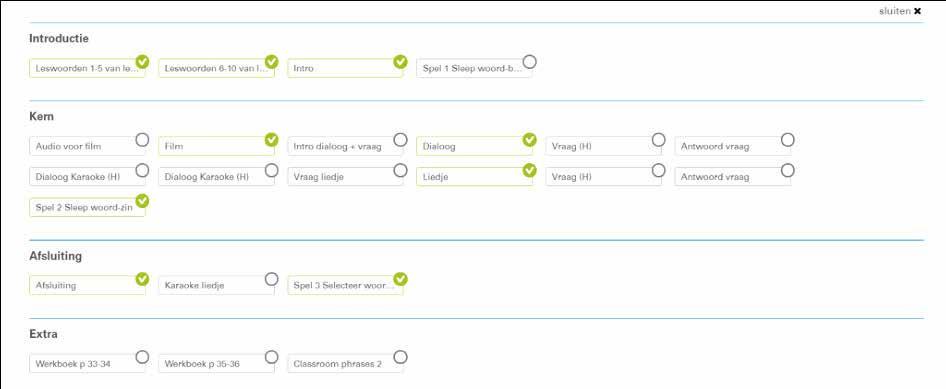
Aan het eind van de les kunnen de leerlingen:
• informatie over de tijd halen uit de film, dialoog en lied, en een paar vragen daarover beantwoorden;
• een dialoog naspreken over op tijd opstaan;
• meezingen met een lied over een meisje dat de volgende dag jarig is.
Aan het eind van de les kennen de leerlingen:
• de leswoorden: clock, an hour, nine o’clock, half past ten, dark, tomorrow, today, to sleep, once a week, awake
Benodigde materialen:
• afsluiting les: kopieerblad 3.10.
Introductie les 2 (10 min)
Kies in het lesmenu welke onderdelen passen bij jouw groep.
De leerlingen maken bij opdracht 1 een lijst van de uren en dagdelen die ze al kunnen zeggen in het Engels. Bijvoorbeeld: 7 o’clock in the morning. Ze schrijven ook op wat ze op dat tijdstip doen. Ze hebben daarbij steun aan de al gegeven zinnen in de opdracht. Als iedereen klaar is, start het spel. Je vraagt een leerling: What do you do at nine o’clock in the morning / three o’clock in the afternoon / six o’clock in the evening? De leerling staat op en noemt zijn bezigheid op dat moment. Wie doet hetzelfde op dat tijdstip? Die gaat bij die leerling staan. Wie doet wat anders? Die mag als volgende een tijdstip en bezigheid noemen. Wie verzamelt de meeste leerlingen? Wie de minste?
Kern les 2 (30 min)
De leerlingen maken tijdens het verwerken de opdrachten 2 t/m 7. Hierbij kijken en luisteren ze nogmaals naar de film en het lied uit les 1. Opdracht 2 en 3 hebben betrekking op de film. Naar aanleiding van de dialoog maken de leerlingen opdracht 4, 5 en 6. Opdracht 7 volgt na het lied. In les 2 is dit lied voorzien van ondertiteling, zodat je met de leerlingen kunt meezingen (zie ook kopieerblad 3.10).
Trek lijnen welke woorden bij elkaar horen.
Kies het juiste antwoord.
Vertalingen van vragen en antwoorden: Engels Nederlands
Audio
Let's look at the film again. Jasmine and Noah want to play computer games.
Vraag What kind of games do you like to play? Raise your hand and tell your teacher which computer games.
Bekijk de film opnieuw. Jasmine en Noah willen computerspellen spelen.
Welke spellen vind jij leuk? Steek je hand op en vertel welke computerspellen jij leuk vindt.
Antwoord Well done, thank you. Goed gedaan, dankjewel.
Vraag Why can’t Charlie get up?
Waarom kan Charlie niet opstaan?
Antwoord Charlie can’t get up because it is still dark. Charlie kan niet opstaan, omdat het nog steeds donker is.
Vraag When is the party for all his friends?

Wanneer is het feestje voor al zijn vrienden?
Antwoord The party for all his friends is on Sunday. Het feestje voor al zijn vrienden is op zondag. Ster-opdrachten
Bij ster-opdracht 1 maken de leerlingen een stripverhaal over te laat komen compleet door de zinnen met het juiste spreekballonnetje te verbinden.
Bij ster-opdracht 2 lezen de leerlingen een gedicht over een kapot horloge. Optioneel is om de leerlingen na het gedicht naar hun favoriete cartoon te vragen.
Afsluiting les 2 (10 min)
Na het verwerken kun je als afsluiting het lied nogmaals met de leerlingen zingen. Gebruik kopieerblad 3.10 als je de songtekst op papier wilt hebben.
Lesdoelen les 3
Aan het eind van de les kunnen de leerlingen:
• uit de dialoog en cartoon informatie halen over de tijd vragen, en het beantwoorden van vragen daarover;
• een dialoog naspreken waarin twee kinderen overleggen hoe laat ze met elkaar zullen afspreken;
• aangeven wat ze op een bepaald tijdstip doen.
Aan het eind van de les kennen de leerlingen:
• de leswoorden: the watch, last week, the morning, the afternoon, the evening, calendar, to rush, to get up, to wake up, lazy;
• de uitspraak van de /f/ en /v/ in woorden als father en video
Benodigde materialen:
• afsluitende opdracht: kopieerblad 3.02.
Introductie les 3 (10 min)
Kies in het lesmenu welke onderdelen passen bij jouw groep.
Introductieopdracht met chant – opdracht 1 verwerken
De leerlingen zeggen bij opdracht 1 de chant na over de tijd. Vertel de leerlingen dat er in het Nederlands nauwelijks onderscheid is tussen de /f/ en de /v/. Laat ze woorden als fiets en vogel na elkaar zeggen. Vertel dan dat er in het Engels wel een groot verschil is. Laat ze luisteren naar de /f/ en de /v/ in woorden als father en video aan de hand van de volgende twee zinnen: My father found four fine fish. en This is a video of the village I visited on vacation.
Kern les 3 (30 min)
De leerlingen maken tijdens het verwerken de opdrachten 2 t/m 6. Na het beluisteren van de dialoog volgen opdracht 2, 3 en 4. Na de cartoon volgt opdracht 5. De laatste opdracht 6 is een TPR-oefening, waarbij je het digibord nodig hebt.
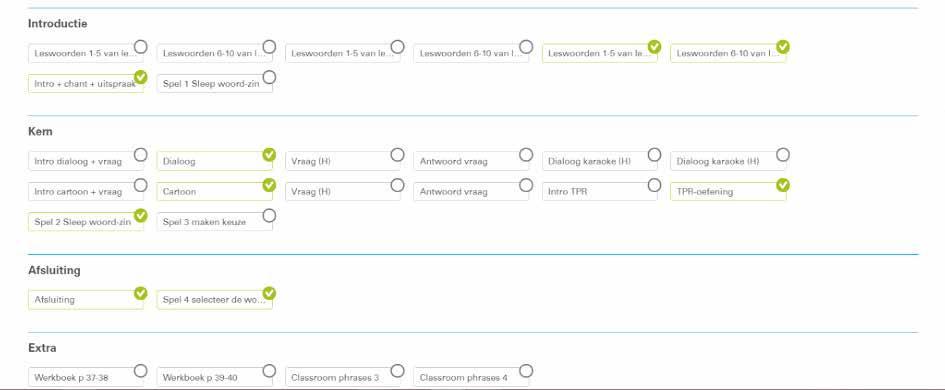
1. Luister en herhaal.
2. Kies het juiste antwoord.
3. Herhaal de dialoog in tweetallen.
4. Maak je eigen dialoog en vul andere dagen en tijden in. 5. Omcirkel het juiste antwoord.
6. Kijk en luister naar Regis.
Vertalingen van vragen en antwoorden: Engels Nederlands
Vraag What time does Sarah normally get up on Saturdays?
Antwoord On Saturdays, Sarah normally gets up at nine o’clock am.
Hoe laat staat Sarah normaal op zaterdag op?
Op zaterdag staat Sarah normaal om 9 uur op.
Vraag Does the truck driver have the right time? Weet de vrachtwagenchauffeur hoe laat het is?
Antwoord The truck driver has the right time, but it isn’t easy to look at the clock. Ja, hij weet hoe laat het is maar het is wel moeilijk om op de klok te kijken.
De co-teacher legt op het digibord uit wat hij doet op een dag. De leerlingen luisteren en maken de opdracht.
Bij ster-opdracht 1 verbinden de leerlingen de leswoorden aan het juiste plaatje. Bij ster-opdracht 2 schrijven de leerlingen in het Engels hun weekendplannen op. Daarna vertellen ze hun plannen aan een klasgenoot.
Afsluiting les 3 (10 min)
Na het verwerken volgt de afsluitende opdracht.
Afsluitende opdracht
De leerlingen maken de TPR-oefening die de co-teacher heeft uitgevoerd, nu zelfstandig. Met behulp van kopieerblad 3.02 maken ze hun eigen time travel van vorige week. Op het kopieerblad staan twee dagen van de week en een aantal klokken zonder wijzers. De leerlingen kiezen een dag (Wednesday or Thursday) en tekenen in elke klok de tijd, en vermelden daarbij de activiteit die ze op dat tijdstip gedaan hebben. Ze kunnen hele en halve uren gebruiken. Als een leerling snel klaar is, kan hij de andere dag ook nog invullen. Tot slot vertellen ze hun time travel avontuur aan de klas.

Extra: de voorbereidingen op unit 4
In de volgende les (unit 4 – les 1) zijn er geen bijzonderheden die nu al opgepakt moeten worden.


1. Step into the time machine!
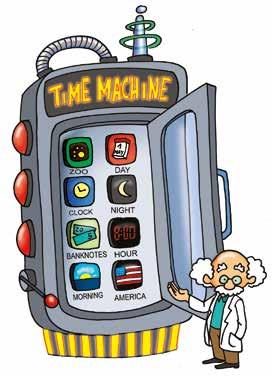
Which words in the picture are about time?
2. What are the children doing in the film?
Tick the right answer.
O They are playing a computer game.
O They are doing their homework.
O They are having something to drink.
3. Fill in the right days of the week.
1. Yesterday was Sunday. What day is it today?
2. Yesterday was Sunday. What day is it tomorrow?
3. Today is Saturday. What day was it the day before yesterday?
4. Today is Friday. What day is it the day after tomorrow?
5. Yesterday was Tuesday. What day is it the day after tomorrow?
4. Listen to the song.
Which days of the week did you hear? Tick the right answers.
O Monday O Wednesday O Friday O Sunday
O Tuesday O Thursday O Saturday
5. Do the dialogue.
Listen and repeat.
Roy: What time is it?
Tom: It is eight o’clock.
Roy: Do you want to go home?
Tom: Yes, I am late, see you!
Work in pairs and repeat the text.
You can also change the time and the place to go. Places to choose from: the zoo – school – the pet shop – the playground – bed – the garden – the supermarket
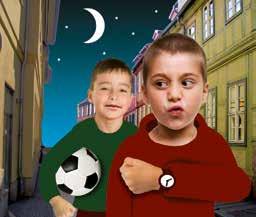
6. Circle the right word.
1. The time / week / day is five o’clock.
2. There are seven days in a time / price / week.
3. On week / Monday / home I go to the supermarket.
4. The day after Saturday is Monday / Wednesday / Sunday.
5. Can you tell me what hungry / day / young it is?
Finished? Do this.
Find the words in the puzzle.
Finished? Find out.
Jack, Tom, Sara and Lisa all have their birthdays in May. Do you know which days they are on?
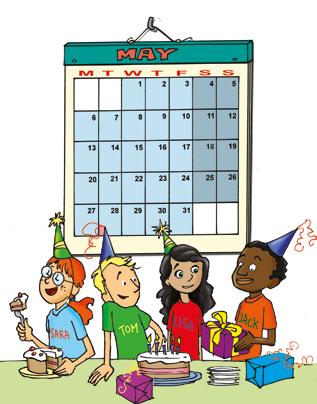
Write down their names on the calendar.
Jack’s birthday is at the weekend. Lisa’s birthday is at the end of the month. Sara’s birthday is on a Thursday. Tom’s birthday is on the same day of the week as Lisa’s.
busy late Sunday
bye Monday tomorrow clock month until
home past up hour Saturday year
Finished? Write down the letters you didn’t cross out. Stop at the ?
Friday awake today
W H B A T A R E Y O U U P G O I Y N G T O H D O N A T H I S E W E T B E K T S E N D ? L T N Q U J N I T
S A C C H O M E S R W L A H W X S M M C Z Y Y W X S F A D A I O S X A G E B C
P K J T R R U D L O K X L Y E I U S R N T L A T E O
R T O R E O D Y O X T P C V H H D M W A R E D J S K
W T R A T C Y I A A A I L N C M Y F R I D A Y R Y L
1. Make a list of the times of the day you can say in English.


For example: 7 o’clock in the morning. Write down what you are doing at that time. Use phrases like: having breakfast (lunch, dinner) – putting my clothes on – going to school – having a break – going home – doing my homework – watching television – playing football – brushing my teeth – reading a book – going to sleep
Finished your list? Then we are going to start a game.
Fill in the table.
What time is it? X
It’s one o’clock. We want to play a computer game. Have you finished your homework? Next question. We’re almost finished.
3. Odd one out.
Tick the word that does not belong.
Example: O apple O banana O car
Car is the odd one out because it is not a piece of fruit.
1. O clock O time O clothes
2. O week O month O school
3. O September O Monday O Thursday
4. O half past ten O five o’clock O half past nine
5. O Saturday O Monday O Sunday
4.
Why can’t Charlie get up? Tick the right answer.
Charlie can’t get up, because
O it is Sunday.
O it is very cold.
O it is still dark.
5. Do the dialogue.
Repeat the text with a classmate.
Mum: Charlie! You have to get up now. It is almost eight.
Charlie: Oh no, not yet. It is too early…
Mum: Come on! You will be late for school.
Charlie: Look outside. I can’t get up now. It is still dark!
Mum: Charlie, this can’t go on any longer. You have to get up earlier!
Charlie: Why? I hate it! You know that! School is boring anyway.
Mum: Great, since you are well awake now, you should get dressed.
Charlie: Okay, okay. Can I have eggs on toast for breakfast?
6. Draw lines. Join the words together.

You can use some words two times.
7. Listen to the song.
When is the party for all his friends?
Tick the right answer.
O tomorrow O Thursday O Sunday O once a week
Finished? Do this.
Draw a line between the phrase and the right balloon.
Come on Raj, hurry up!
What time is it?
So you think school starts at nine o’clock?
Gloria, wait for me!
Look! Mr Bond is waiting for us. It is already half past nine. Oh no, what will he say?
Finished? Read the poem.
It is about about a watch that isn’t working anymore.
My watch is broken, so I can’t tell the time. I don’t know if it’s midnight or a quarter past nine. (...)
What time could it be?
I hope that it’s three, because that’s when my favourite cartoon’s on TV. (...)
What is your favourite cartoon on television?
1. Listen and repeat.
Tick tock, tick tock says the clock, says the clock. Tick tock, tick tock I know the time. It is ten o’clock.
What time does Sarah normally get up on Saturdays? Tick the right answer.
On Saturdays, Sarah normally gets up at O half past eight.
O eight o’clock. O nine o’clock. O half past nine.

Repeat the text with a classmate.
Thom: Can I stay at your house next Friday?
Sarah: Yes, of course. But I have to get up early on Saturday.
Thom: What time do you have to get up?
Sarah: Half past eight.
Thom: You call that early?!
Sarah: Well, normally I get up at nine o’clock!
Thom: Ha, ha! You are a lazy girl!
4. Make your own dialogue.
Use other days of the week and a new time.
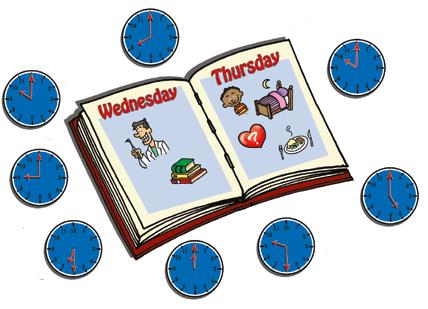
Thom: Can I stay at your home next ?
Sarah: Yes, of course. But I have to get up early on .
Thom: What time do you have to get up?
Sarah: At half past
Thom: You call that early?!
Sarah: Well, normally I get up at o’clock!
Thom: Ha, ha! You are a lazy girl!
Repeat your text with a classmate.
5. Watch the cartoon.
Circle the right answers.
1. The truck driver has / hasn’t got the right time.
2. It is / isn’t easy to look at the clock.
6. Look and listen.
Draw a line from the diary to the right clock.
this.
Finished? Be creative.
What are your plans for the coming weekend? Write the times and your plans in your diary. Make small drawings of your plans. You may also write them in English.
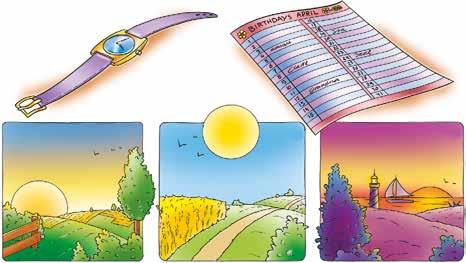
Finished? Read your diary to a classmate.
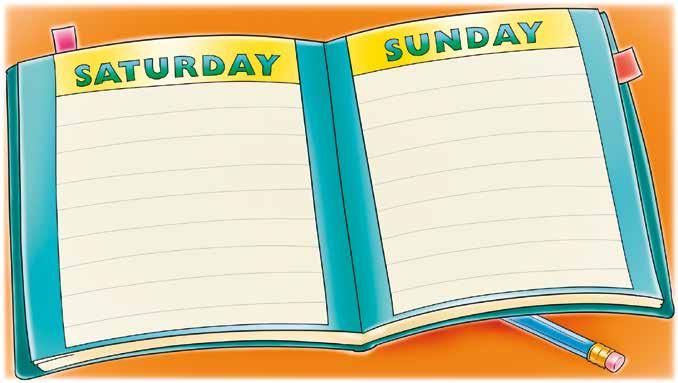
afternoon middag awake wakker a day een dag a week een week an hour een uur calendar kalender

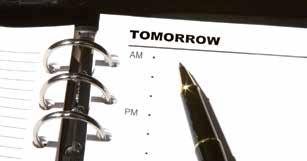

once a week een keer per week Saturday zaterdag Sunday zondag Tuesday dinsdag Thursday donderdag today vandaag tomorrow morgen
clock klok dark donker diary agenda evening avond Friday vrijdag half past ten half elf last week vorige week lazy lui Monday maandag morning ochtend nine o’clock negen uur
the time de tijd the watch het horloge to get up opstaan to rush haasten to sleep slapen to wake up wakker worden Wednesday woensdag

LESBESCHRIJVINGEN 7/8A
De proeflessen, lesbeschrijvingen en de antwoorden kun je ook gratis downloaden op; www.thiememeulenhoff.nl/takeiteasy/proeflessen
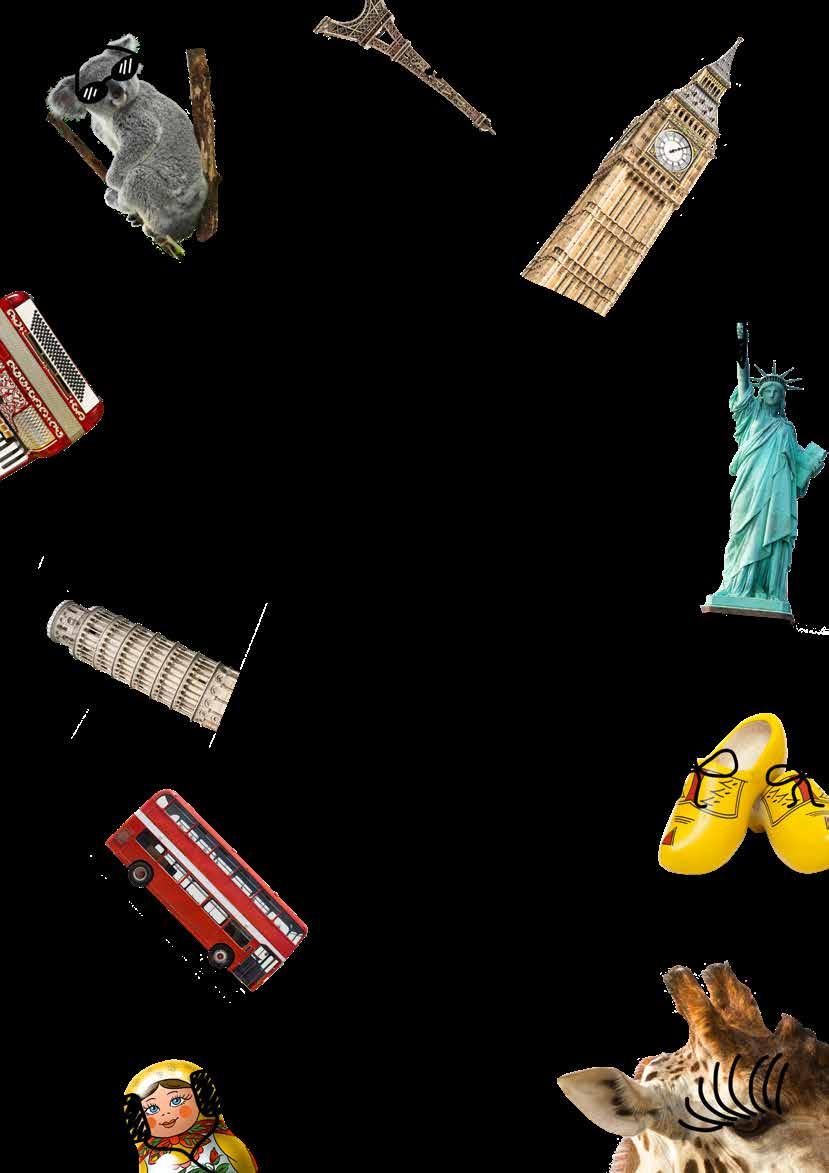

Lesdoelen les 1
Aan het eind van de les kunnen de leerlingen:
• informatie over het wijzen van de weg halen uit de film, het lied en de leestekst en vragen daarover beantwoorden.
Aan het eind van de les kennen de leerlingen:
• de leswoorden: city map, crossroads, pavement, a waste of time, impossible, to get a taxi, to show the way, village, to cross the road, first, second, third.
Benodigde materialen:
• niet van toepassing.
Introductie les 1 (10 min)
Kies in het lesmenu welke onderdelen passen bij jouw groep.
Introductieopdracht – opdracht 1 verwerken
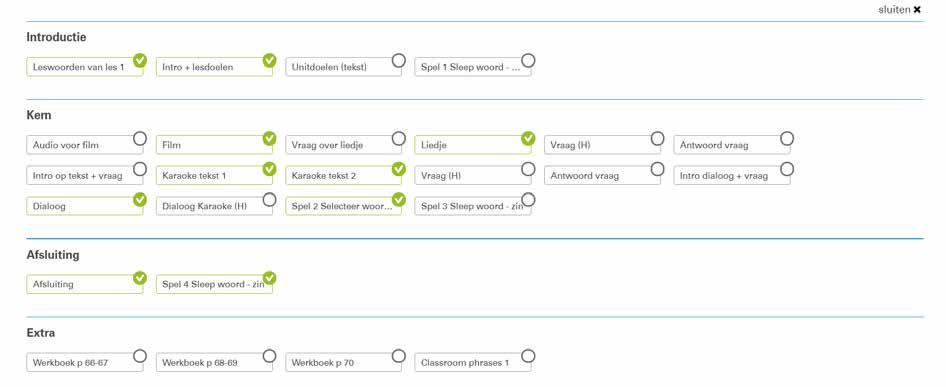
Je laat een stadsplattegrond zien, bijvoorbeeld via Google Maps. Vraag de leerlingen welke gebouwen erop te zien zijn. Vraag daarna:
• Has anyone ever asked you the way when they were lost? Maybe even in English? What did they say and what did you tell them?
(Heeft iemand jou ooit de weg gevraagd toen zij verdwaald waren? Misschien zelfs in het Engels? Wat zeiden zij en wat heb jij hen verteld?)
Leg een link tussen de weg vragen / volgen en computerspelletjes. Daar moeten de leerlingen ook vaak een route volgen. Wijs op de symbolen en woorden bij opdracht 1. Welke woorden lijken op het Nederlandse woord? De leerlingen schrijven deze op. Daarna trekken ze een lijn van het woord naar het plaatje dat erbij hoort.
Kern les 1 (30 min)
De leerlingen maken tijdens het verwerken de opdrachten 2 t/m 6. Na het bekijken van de film maken ze opdracht 2, gevolgd door opdracht 3 na het lied. Opdracht 4 hoort bij de leestekst en opdracht 5 en 6 maken de leerlingen na de dialoog.
1. Trek een lijn van het woord naar de juiste afbeelding.
2. A. Kies het juiste antwoord. B. Trek een lijn van de zin naar de juiste afbeelding.
Audio
Let’s watch the film. The film is about two children who live in a town. They want to find the way to a museum.
We gaan film kijken. Deze gaat over twee kinderen die in een stad wonen. Ze willen de weg naar een museum weten.
Vraag What shall we do? We don’t have any money. Wat zullen we doen? We hebben geen geld.
Antwoord Yes, I suppose we have to walk. Ja, ik denk dat we moeten lopen.
Vraag Why do the girls feel dizzy? Is it because they’re doing too much sightseeing or because they got on the London Eye?
Antwoord
Vraag
Antwoord
The girls feel dizzy for two reasons: because they’re doing too much sightseeing and because they got on the London Eye.
What do you think the text is about?
The text is about places you can visit in London, like London Zoo and the London Eye.

Waarom zijn de meisjes duizelig? Is het omdat ze te veel bezichtigen of omdat ze in de London Eye zijn?
Het komt door allebei.
Waar gaat de tekst over denk je?
De tekst gaat over plekken die je kunt bezoeken in Londen, zoals London Zoo en de London Eye.
Extra uitleg bij opdracht 6
Verdeel de leerlingen in groepjes van vier, maar speel het spel ‘I’m going to the themepark’ eerst een keer klassikaal. De leerlingen gebruiken daarbij de plattegrond. De eerste leerling zegt: ‘I’m going to the themepark and I …(geeft een richting aan). De volgende leerling herhaalt de woorden van de eerste leerling en voegt er een richting aan toe. Ga zo verder. Als iemand het niet meer kan onthouden, is diegene af. Schrijf de volgende begrippen als geheugensteun op het lijntjespapier (onder de ABC-knop op het digibord): turn left/right at the crossroads, go straight on, take the first street on the left/right, turn round the corner, cross the river, pass the castle.
Bij ster-opdracht 1 volgen de leerlingen een route op de plattegrond. Ze vullen de missende leswoorden in de routebeschrijving in. Als ze dit goed gedaan hebben, komen ze erachter waar de schat verstopt ligt. Bij ster-opdracht 2 maken de leerlingen een wegstreeppuzzel. Zo oefenen ze nogmaals de leswoorden. Als ze dit goed doen, lezen ze aan het eind een zin in de puzzel.
Afsluiting les 1 (10 min)
Na het verwerken volgt de afsluitende opdracht.
Afsluitende opdracht Zie opdracht 6.
Aantekeningen
Aan het eind van de les kunnen de leerlingen:
• Informatie over het vragen van de weg halen uit de film, het lied en de leestekst en vragen daarover beantwoorden;
• het werkwoord to go in de tegenwoordige en in de verleden tijd gebruiken;
• meezingen met het lied over een bezoek aan Londen.
Aan het eind van de les kennen de leerlingen:
• de leswoorden: the post office, the town hall, mosque, cinema, museum, bookshop, department store, railway station, church, swimming pool
Benodigde materialen:
• afsluiting les: kopieerblad 4.13.
Introductie les 2 (10 min)
Kies in het lesmenu welke onderdelen passen bij jouw groep.
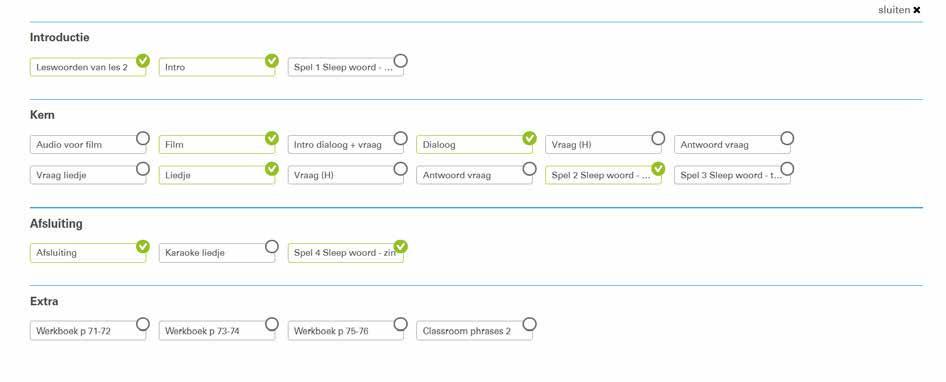
De leerlingen trekken een lijn van de afbeelding naar het juiste woord. Daarna schrijven ze de gebouwen die wel of niet in hun eigen woonplaats voorkomen in de juiste kolom. Ze hebben keuze uit de kolommen: In my village/town/city there is a … en In my village/town/city there isn’t a … Tot slot checken ze hun antwoorden met een klasgenoot.
Kern les 2 (30 min)
De leerlingen maken tijdens het verwerken de opdrachten 2 t/m 7. Hierbij kijken en luisteren ze nogmaals naar de film en het lied uit les 1. Opdracht 2 heeft betrekking op de film. Naar aanleiding van de dialoog maken de leerlingen opdracht 3, 4, 5 en 6. Opdracht 7 volgt na het lied. In les 2 is dit voorzien van ondertiteling zodat je met de leerlingen kunt meezingen (zie ook kopieerblad 4.13).
6. Maak de zinnen af in tweetallen.
5. Maar de zin af door het juiste woord in te vullen.
words. 1. You can see paintings here. It is a 2. A king, a queen or a knight used to live here. It is a 3. You can have dinner here. It is a 4. You can watch a movie here. It is a 5. You can get on the underground here. It is an
Vertalingen van vragen en antwoorden: Engels Nederlands
Audio
Lily likes sightseeing in Amsterdam. Have you ever been sightseeing? Tell your classmate if you ever have gone sightseeing, and where that was.
Lily houdt van bezienswaardigheden bekijken in Amsterdam. Heb jij ook ooit bezienswaardigheden bekeken in een stad? Zo ja, vertel aan je klasgenoot waar je dat hebt gedaan.
Vraag [geïntegreerd in film] [geïntegreerd in film]
Antwoord [eigen antwoord] [eigen antwoord]
Vraag How should Nadia and her mother travel to Tower Hill Station?

Antwoord Nadia and her mother should travel to Tower Hill Station on the underground. They can take the Circle Line.
Vraag What do they visit in one day?
Antwoord They visit Westminster Abbey, London Zoo, Madame Tussauds and the London Eye.
Hoe komen Nadia en haar moeder bij Tower Hill Station?
Nadia en haar moeder moeten met de metro reizen. Ze kunnen de Circle Line pakken.
Wat bezoeken ze in één dag?
Ze bezoeken Westminster Abbey, London Zoo, Madame Tussauds en de London Eye.
Bekijk samen met de leerlingen de Phrases to know. Je bespreekt het werkwoord to go met de leerlingen. Bespreek de tegenwoordige tijd: I go, you go, he/she/it goes, we go, you go, they go
En de verleden tijd: I went, you went, he/she/it went, we went, you went, they went
Sta even stil bij het woord it. Vertel dat je it gebruikt wanneer het niet terugslaat op een persoon, maar op een ding. Laat de leerlingen dan om de beurt de voorbeeldzinnen uitspreken. Vraag steeds: is dit tegenwoordige tijd (today) of verleden tijd (yesterday)?
Bij ster-opdracht 1 maken de leerlingen een puzzel. Ze oefenen zo hun kennis van de leswoorden. Bij ster-opdracht 2 werken de leerlingen in tweetallen. Ze geven de beroemde gebouwen in de foto de juiste namen. Hierbij kunnen ze ook gebruik maken van het internet.
Na het verwerken kun je als afsluiting het lied nogmaals met de leerlingen zingen. Gebruik kopieerblad 4.13 als je de songtekst op papier wilt hebben.
Aantekeningen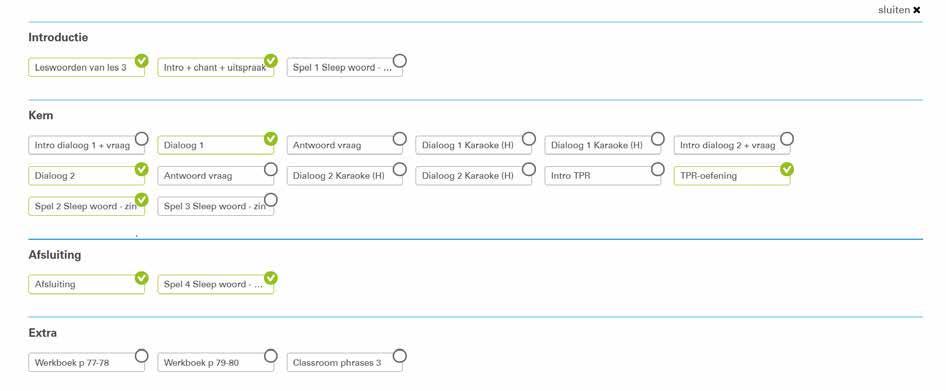
Lesdoelen les 3
Aan het eind van de les kunnen de leerlingen:
• woorden met een /eei/- klank als in wait, railway station en wail correct uitspreken;
• een dialoog naspreken over de weg wijzen;
• het werkwoord can gebruiken in een vraag- en antwoordzin.
Aan het eind van de les kennen de leerlingen:
• de leswoorden: to pretend, to play sports, recorder, to paint a picture, to sing a song, talent, bored, famous, to get cross, judo;
• de rangtelwoorden first, second en third.
Benodigde materialen:
• ster-opdracht 2: (eventueel) een woordenboek NL-ENG.
Introductie les 3 (10 min)
Kies in het lesmenu welke onderdelen passen bij jouw groep.
Introductieopdracht met chant – opdracht 1 verwerken
De leerlingen zeggen bij opdracht 1 de chant over de weg vragen na. In deze chant staat uitspraak van de /ee/-klank centraal. Bespreek met de leerlingen de uitspraak van de Engelse /ee/ (je schrijft vaak /ay/ of /ai/). Deze klinkt anders dan de Nederlandse /ee/. De Engelse /ee/ gaat meer richting /ei/, een dubbelklank dus. Je vindt deze Engelse /ee/ onder meer in de woorden wait, way en today. Om deze klank te vormen, begin je de klank met de /ee/. Daarna ga je over op de /ie/, door de tong naar boven te bewegen. Oefen dit met de leerlingen.
Kern les 3 (30 min)
De leerlingen maken tijdens het verwerken de opdrachten 2 t/m 7. De leerlingen luisteren in deze les naar twee verschillende dialogen. Hier horen de opdrachten 2, 3, 4, 5 en 6 bij. De laatste opdracht 7 is een TPR oefening waarbij je het digibord nodig hebt.
2. Kies het juiste antwoord.
3. Herhaal de dialoog in tweetallen.
2. Listen to the dialogue. Tick the right answer. The Empire State Building is on 5th Avenue. O true O false
3. Do the dialogue.
Listen again and repeat the phrases.
Jamie: Isn’t it terrific to be in New York! Everything is so big!
Sammy: Where shall we go? Jamie: Let’s do some sightseeing in the morning.
Sammy: OK. I’d like to visit the Empire State Building. Let’s have a look at the map.
Jamie: We are here, in the city centre, in front of Central Park. We take the second street on the left. At the second crossroads we turn right.
Sammy: Right. Then we go straight on until we come to the Empire State Building.
Jamie: It’s between 34th and 33rd street on 5th Avenue. We’ll take the lift to the top!
Sammy: We’ll have a wonderful view of New York! Repeat the text with a classmate. seventy-three
4. Zet de woorden onder de juiste afbeelding, in tweetallen.
5. A. en B. Omcirkel het juiste antwoord.
Dialoog 1
Vraag True or false: The Empire State Building is on 5th Avenue? Juist of onjuist: het Empire State Building ligt aan de 5th Avenue?
Antwoord True. The Empire State Building is on 5th Avenue. Juist.
Dialoog 2
Vraag Where are Bobby and his mum when they find out they have lost Bobby’s father?
Antwoord Bobby and his mum are at the entrance to a large department store, in a street.
Extra uitleg bij opdracht 6
Waar zijn Bobby en zijn moeder als ze er achter komen dat ze Bobby’s vader kwijt zijn?
Bobby en zijn moeder staan op straat, bij de ingang van een groot warenhuis.
Laat de leerlingen eerst de dialoog in tweetallen oefenen. Hierna bespreek je klassikaal hoe je in het Engels naar de weg vraagt en hoe je antwoord geeft als mensen de weg vragen aan jou. Neem de manieren om de weg te vragen en de beschreven richtingen in Phrases to know klassikaal door. Benadruk dat het turn left/right is en niet, zoals in het Nederlands, go right/left. Herhaal ook nogmaals de rangtelwoorden first, second en third met de leerlingen.
TPR oefening – opdracht 7
De co-teacher geeft aanwijzingen voor een griezelroute door het stadje York. De leerlingen tekenen deze route op de plattegrond van opdracht 7.

Bij ster-opdracht 1 maken de leerlingen een Engelse e-mail af door de leswoorden op de juiste plaats in te vullen. Bij ster-opdracht 2 schrijven de leerlingen een korte e-mail in het Engels over hun woonplaats op dezelfde manier als in ster-opdracht 1. De leerlingen kunnen hier een woordenboek bij gebruiken. Daarna tekenen ze een plattegrond van wat zij hebben opgeschreven. Ze lezen hun tekst voor aan een klasgenoot die controleert of de getekende plattegrond overeenkomt met de tekst.
Afsluiting les 3 (10 min) Na het verwerken volgt de afsluitende opdracht.
Afsluitende opdracht Gebruik hierbij nog een keer de plattegrond van York van opdracht 7. De leerlingen werken in tweetallen. Eén leerling kiest een plaats op de plattegrond en leidt een klasgenoot daar via aanwijzingen naartoe. Als deze op de plek gearriveerd is, wisselen ze van rol. Zet als steun de volgende zinnen op het digibord: go straight on, turn left/right, cross the…, pass the…, take the first, second, third street on the left/right enzovoort.

Aan het eind van de les kunnen de leerlingen:
• de weg vragen en wijzen;
• de trappen van vergelijking in een zin gebruiken.
Aan het eind van de les kennen de leerlingen:
• de leswoorden: trip, sightseeing, useful, attraction, to discover, a view, car park, souvenir shop, to read a map, a big city;
• de trappen van vergelijking van woorden als tall, large en famous.
Benodigde materialen:
• opdracht 5, 6 & 7: kopieerblad 4.01 (bij opdracht 5 twee plattegronden losknippen);
• ster-opdracht 2: vel papier, schaar, lijm, schrijfmateriaal, afbeeldingen van attracties en monumenten in Londen (via internet / tijdschriften / reisfolders), plattegrond van Londen;
• afsluitende opdracht: kopieerblad 4.02 en 4.03.
Introductie les 4 (10 min)
Kies in het lesmenu welke onderdelen passen bij jouw groep.
Introductieopdracht – opdracht 1 verwerken
Vraag de leerlingen welke bezienswaardigheden ze zouden willen zien als ze een grote stad zouden bezoeken. Willen ze bijvoorbeeld the cinema, a zoo of a market zien? Je noteert een aantal mogelijkheden op het digibord. Vraag dan: wat valt onder entertainment en wat onder shopping? Daarna maken de leerlingen opdracht 1.
Kern les 4 (30 min)
De leerlingen maken tijdens het verwerken de opdrachten 2 t/m 7. De leerlingen lezen de tekst, kijken naar de cartoon en doen de spreekopdracht. Opdracht 2 en 3 hebben betrekking op de leestekst. Naar aanleiding van de cartoon maken de leerlingen opdracht 4. Opdracht 5, 6 en 7 vormen samen de spreekopdracht.
3. Read the phrases. Phrases to know If you want to say something about a building or a place, you can say:it is tall large it is famous / exciting If you compare this with another building or place, you can say:It is taller than that building… when it is a short word It is more exciting than that place… when it is a longer word If there is no other building or place
6. Practise Work in pairs. Choose who will play the tourist and who will play the passer-by The tourist asks the way to a building on the map. Find out what you need to do and say. Use the Phrases to know Unit 4 lesson 3 Tourist: asks where the … (post office, town hall, ...) is. Passer-by: says he she knows and describes the way to … Tourist: draws this way on his / her map. Tourist: repeats the way: First … Passer-by: That s it! if it s correct or describes the way again if it Tourist: says thank you. Passer-by: says you’re welcome.
7. Act it out. One of you plays the tourist, and the other one plays the passer-by. Act out your conversation.
Kies het juiste antwoord.
Kruis de gevonden antwoorden aan.
Speel de dialoog in tweetallen.
Acteer jullie dialoog.
Vertalingen van vragen en antwoorden: Engels Nederlands
Leestekst
Vraag Which attraction do you like the most? Can you say why? Welke attractie vind jij het leukst? En waarom?
Antwoord I don’t know which attraction you would choose. They’re all attractive, don’t you think?
Vraag
Is a navigation system always useful when you want to find your way?
Antwoord A navigation system can be useful, but not always. Not if you don’t know your right from your left!
Extra uitleg bij opdracht 3
Ik weet niet welke attractie jij zou kiezen. Ze zijn allemaal aantrekkelijk, vind je niet?
Is een navigatie systeem altijd handig om de weg te vinden?
Nee, niet altijd. Niet als je niet weet wat links en rechts is.
Je bespreekt met de leerlingen de trappen van vergelijking. Noem als voorbeeld: groot, groter, grootst. Vertel dat je een trap van vergelijking gebruikt als je een voorwerp, gebouw of plaats met een ander voorwerp, gebouw of plaats wilt vergelijken. Lees samen de zinnen bij Phrases to know. Leg uit dat bijvoeglijke naamwoorden die bestaan uit één lettergreep bij de vergrotende en de overtreffende trap de uitgangen -er en –est krijgen (tall, taller, tallest). Bijvoeglijke naamwoorden met twee lettergrepen of meer krijgen more en most voor het bijvoeglijk naamwoord. Geef als voorbeelden: It is exciting, it is more exciting, it is the most exciting. Maak klassikaal de rest van de opdracht.
De leerlingen gaan de geleerde stof nu in de praktijk brengen door in tweetallen een dialoog te bedenken en uit te voeren. In deze les gaat de dialoog over hoe je in het Engels de weg vraagt en de weg wijst. De leerlingen bereiden zelf de dialoog voor bij opdracht 5 en 6. Bij opdracht 7 voeren de leerlingen de dialoog uit. Bij opdracht 5 heb je kopieerblad 4.01 nodig. De leerlingen krijgen Map A of Map B en geven aan welke gebouwen zij op hun plattegrond zien staan. Maar zij laten de plattegrond niet aan elkaar zien. Voor opdracht 6 & 7 is hetzelfde kopieerblad nodig. De leerling die Map A heeft gekozen, vraagt de weg naar de gebouwen die staan aangegeven. De andere leerling vertelt de weg. De leerling die de weg vraagt, tekent deze route op zijn plattegrond. Check daarna samen of het klopt. Hierna wisselen de leerlingen en vraagt de leerling die Map B heeft gekozen naar de aangegeven gebouwen.
Bij ster-opdracht 1 verbinden de leerlingen de verkeersborden met de juiste Engelse betekenis. Ze ontwerpen ook hun eigen verkeersbord.
Bij ster-opdracht 2 beschrijven de leerlingen in het Engels de route naar een zelfgekozen beroemde attractie of monument in Londen. Ze maken er een vakantiebrochure over. Zorg ervoor dat de leerlingen een plattegrond van Londen hebben. Download bijvoorbeeld een simpele toeristenplattegrond van internet.
Afsluiting les 4 (10 min)
Na het verwerken volgt de afsluitende opdracht.
Afsluitende opdracht:
Vier kinderen krijgen ieder een andere plattegrond. Je vindt de vier verschillende plattegronden op kopieerblad 4.03. Iedere leerling stelt zich op in een hoek van de klas. De andere leerlingen kruisen op kopieerblad 4.02 vijf gebouwen aan die ze het liefst in hun ‘ideale’ stad zouden willen hebben. De leerlingen gaan bij de vier leerlingen met een plattegrond langs en vragen of deze gebouwen voorkomen op hun plattegrond. Ze vragen steeds: Is there a…(swimming pool) in your town? Als ze alle vier de leerlingen gehad hebben, gaan ze bij de leerling staan met de plattegrond waarop de meeste gebouwen van hun lijst voorkomen. De plattegrond waarbij de meeste leerlingen staan, benadert het dichtst de ideale stad.
Aan het einde van de les kunnen de leerlingen:
• vragen beantwoorden na het beluisteren van een dialoog;
• vragen beantwoorden over de leswoorden van deze unit;
• vragen beantwoorden na het lezen van een tekst;
• de grammatica van deze unit op de juiste manier gebruiken.
Benodigde materialen:
• blinddoek;
• plattegrond (eventueel).
Introductie toetsles 5 (10 min)
Kies in het lesmenu welke onderdelen passen bij jouw groep.
In de toetsles van unit 4 worden alle leswoorden en taal- en grammaticaregels herhaald uit de voorgaande lessen. Je bekijkt samen, of je laat de leerlingen zelfstandig de Phrases to know en de Words to know herhalen. Ook komen de verschillende grammatica schermen aan bod om de taalregels en afspraken nog eens te bespreken.

Nog beter is het om de grammatica ook al in eerdere lessen in te zetten.
De vervoeging van het werkwoord to go. Bijvoorbeeld: Tegenwoordige tijd: I go, you go, he/she/it goes, we go, you go, they go Verleden tijd: I went, you went, he/she/it went, we went, you went, they went
De manier waarop je informeert naar de weg en hierop antwoord geeft. Bijvoorbeeld: Excuse me, can you tell me the way? Of course, you have to go straight on. You have to take the first turning on the left.
De trappen van vergelijking. Bijvoorbeeld: Tall, taller, tallest It is exciting, it is more exciting, it is the most exciting.
Kern toetsles 5 (25 min)
De leerlingen maken de individuele toets. Bij opdracht 1 hoort altijd een luistertekst die op het digibord klassikaal is te beluisteren. Je kunt deze tekst meerdere keren laten horen. De toets in unit 4 betreft 8 opdrachten. De toetsnormering staat op de methodestartpagina onder Leerlijnen en doelen.
Meer dan 31 punten goed cijfer 8 / 10 Tussen 22 en 31 punten voldoende cijfer 5.5 / 7.5
Minder dan 22 punten niet voldoende (nog een keer oefenen) cijfer 5.5 en lager Snellere leerlingen kunnen de extra toetsopdracht maken, zie de methodestartpagina onder Opdrachten ‘Test – an extra question’, of zie de verwerkingssoftware via Extra exercises waar ook een extra puzzel staat.
Circle the right answer.
We have got a garden behind / under our house.
The bookshop is over next to the cinema.
There is a forest near / over the village.
The museum is across from on the supermarket.
Write down the correct verbs.
the verb: to go.
I ___________ shopping a lot.
Afsluiting toetsles 5 (10 min)
7. Write down the correct words.
Choose from: big city – city map – useful – read a map – car park
1. London is a very _______________, you will need a _______________ to find your way around.
2. When you are going on holiday, it is very _______________ if you know how to _______________. 3. This _______________ is full, so we need to park the car somewhere else.
big city city map useful read a map car park
8. Read the text and circle the right answer.
Kim: I’m afraid we’ve lost Dad again.
She always ___________ to the bookshop. 3. The policeman ___________ to the police station every Monday. 4. Yesterday ___________ to the city centre.
go goes goes went
6. Circle the right answer. 1. Which word does not belong in this list? church b. city centre c. cinema d. department store 2. Which word does not belong in this list? a. crossroads b. corner c. trip d. square 3. Where do you wear a swimsuit? a. bookshop b. swimming pool restaurant d. railway station
4. Where can you get your passport? bookshop b. town hall c. zoo d. souvenir shop
5. Where can you catch the train? a. cinema b. swimming pool c. mosque d. railway station 6. What do you need to find the way? a. city centre b. city map city corner d. city square
Mum: We always lose each other when we go shopping. Where did we last see him?
Kim: In that computer shop near the railway station. How do we get there from this department store? Let’s ask somebody.
Kim: Excuse me mister, could you tell me where the computer shop is, please?
Man on the street: Yes, of course. Turn left when you exit the store, then you pass a little market, and at the end there is the computer shop. It is next to the cinema and across from the post office. It is only a few minutes from here.
Kim: Thank you. Let’s go find Dad.
1. The family lost their dog. true false 2. The last time they saw Dad was at the cinema. true false 3. They are at the department store right now. true false 4. They ask somebody to tell them the way. true false 5. The computer shop is next to the cinema. true false 6. The department store is across the street from the post office. true false
16
Je sluit de unit af met één of twee Taalspelen:
• Je gaat een spel spelen met de hele groep. In het spel ligt het accent op spreekvaardigheid. Een leerling is geblinddoekt. Je leidt hem door het lokaal heen op weg naar de plaats van bestemming, bijvoorbeeld het bord, de linkerhoek, het raam of de prullenbak. Daarbij gebruik je de woorden voor ‘de weg wijzen’. Je kunt een aantal handige woorden en zinnen op het bord schrijven. Dit spel kan een aantal keer herhaald worden, waarbij ook de ene leerling een andere leerling kan leiden. Ook kun je de leerlingen dit spel in groepjes van twee laten spelen.
• Toon het scherm op het digibord en vertel de leerlingen dat ze het spel Bestemming raden (Giving directions) gaan spelen. Deel de leerlingen op in tweetallen. Een van de leerlingen neemt een bekende plek in de buurt van de school in zijn hoofd. Hij legt vervolgens aan de andere leerling uit hoe je er vanaf de school kunt komen. Weet de andere leerling waar het is en kan hij de bestemming raden? Wissel dan van rol. Gebruik hier eventueel een plattegrond van de omgeving bij.
Extra: voorbereiden op unit 5 In de volgende les (unit 5 – les 1) zijn er geen bijzonderheden die nu al opgepakt moeten worden.
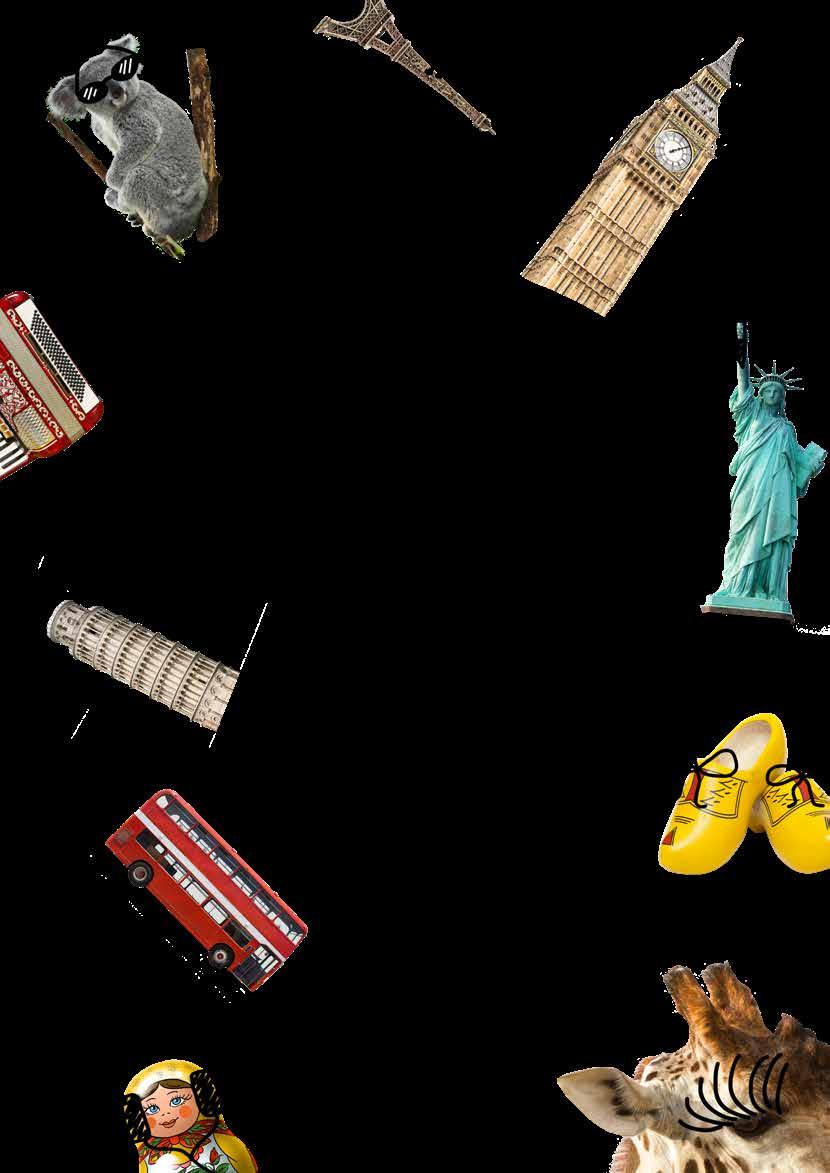

1. Draw a line from the word to the right picture. go straight on turn right turn left road bridge crossroads pavement bank post office church






Write down the words that look like Dutch words.
2. Where do Liam and Lily want to go to in the film?
A. Tick the right answer.

O They want to go to the square.
O They want to go to Madame Tussauds.

O They want to go to the car park.
O They want to go to the city centre.
B. Match the sentence to the picture. Here is a city map. Shall we get a taxi?
We need to turn left. What do we do at the crossroads? It’s a church.

3. Listen to the song.
Why do the children feel dizzy?
Tick the right answer.
They feel dizzy because:
O they are very sleepy.
O they have done too much sightseeing.
O they have done too much sightseeing and they went on the London Eye.
4. Look at the text.
What do you think the text is about?
Tick the right answer.
O The text is about how monkeys live.
O The text is about places you can visit in London, like London Zoo.
O The text is about how to get the best view of London.
With 12,000 animals, you’re sure to discover plenty to entertain and inform. Don’t miss ‘Meet the Monkeys’, an exciting monkey walk-through experience or the new exhibit, ‘Into Africa’, where you will see some of Africa’s most unusual animals.

The London Eye is where you should go for the best views of London! The world’s largest observation wheel is 135 m (443 ft) high and is situated on the Southbank opposite the Houses of Parliament. On a clear day views are a stunning 40 km (25 miles) so you can see all of London at once!

5. Do the dialogue.
Listen and repeat the phrases.
Mr Walker: Excuse me, Sir, can you tell me where Tower Bridge is?
Policeman: Sure! You turn left at the crossroads, you pass the bridge and then you go straight on. You follow the River Thames till you come to Tower Bridge.
Mr Walker: Thank you.
Policeman: You’re welcome.
6. Play a game.
Are you good at remembering directions?
Work in groups of four. Play the directions game.
1. I’m going to the theme park and I (turn left / go straight on / ….).
2. I’m going to the theme park and I (turn left / go straight on / …) and …
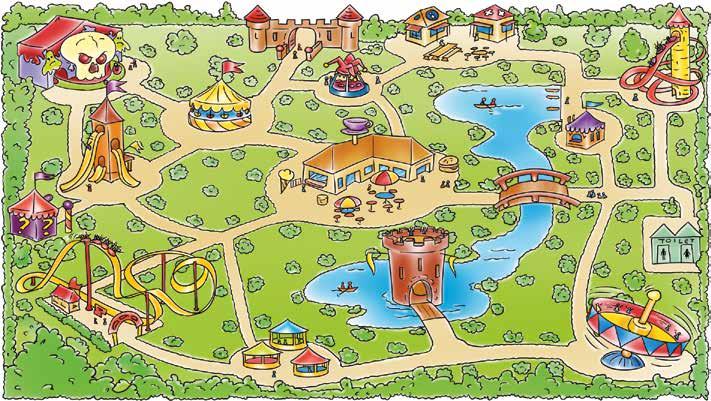
A new direction is added each time. The game ends when one of you can’t repeat the directions correctly.
entrance
Finished? Do this.
Find the treasure. Fill in the gaps.
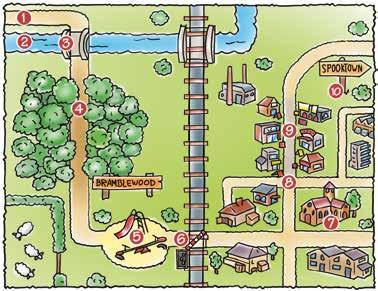
Follow the (1) beside the (2)
Cross the (3) and go into the (4) When you come out of the (4) you walk across the (5) Go straight on and cross the (6) level crossing. You come into the village and turn left at the (7) Go straight on at the (8) and you enter the main shopping street. Walk on the (9) and follow the (10) out of the village to Spooktown.
Where is the treasure hidden? Find the word.
Letter 1 is the first letter of word 7.
Letter 2 is the first letter of word 2.
Letter 3 is the seventh letter of word 5.
Letter 4 is the fourth letter of word 8.
Letter 5 is the tenth letter of word 8.
Letter 6 is the second letter of word 3.
Letter 7 is the second letter of word 4.
Letter 8 is the second letter of word 9.
Letter 9 is the fourth letter of word 1.
Letter 10 is the first letter of word 10.
1 2 3 4 5 6 7 8 9 10
The treasure is hidden at the
Finished? Make a puzzle.
Find the words for buildings and places in a town. Cross out the letters in the puzzle.
sch-l br-dg- s-gnp-st r-d p-l-c- st-t-n cr-ssr-ds str-t m-rk-t ch-rch p-v-m-nt c-rner pl-gr-nd r-v-r r-nd-b-t sq-r-
Finished?
Write down the letters you did not cross out. What sentence do they spell?
Nice to know
The London underground: There’s a big and very complicated network of train tracks connecting about 270 stations in England’s capital city, and most of the time the trains travel underground. Going by ‘tube’ is a cheap and quick way to get around London.
W P H E R N S T S E T Y O
S U A E W C A U I G E N T T D V V H O F O G D K I C N I A O E D S B N I R O O R M O O E M T A P R A H R
I L N G R I E D O B M N N E R A U Q S A N S N O T E H C R U H C S U T H E R R T P L A Y G R O U N D O W N S T R E E T R R R O A D B U Y A T O W N P C L A N N O I T A T S E C I L O P


1. Draw a line from the word to the picture. a school a church a post office a mosque a town hall a museum a police station a swimming pool a bank a railway station








Which of the buildings above are in your town or village? Which buildings aren’t? Write down the word in the right column. In my village / town / city there is a ... In my village / town / city there isn’t a …
Finished? Check with your classmate. Use the correct English phrase above the column.
2. Fill in the table.
A. Read the words. There are words about transport and about giving directions. Put them in the right column.
read the map – get a taxi – walk straight on – turn left – take the bus –at the crossroads – turn right at the church – go to the car park – we have to walk Transport Giving directions
B. What do Liam and Lily not do in the film? Tick the right answers.
O They get a taxi.
O They look at an online city map.
O They take the bus.
O They turn right at the crossroads.
O They walk to Madame Tussauds.
O They get a lift.
3. Listen to the dialogue.
How should Nadia and her mother travel to Tower Hill Station? Circle the right answer.
Nadia and her mother should travel to Tower Hill Station on foot / on the underground. They can take the Circle Line / the Central Line.
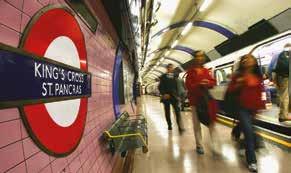
4. Answer the question about the dialogue.
How do Nadia and her mother walk from Tower Hill Station to The Tower of London?
Fill in the gaps. Choose from: souvenir shop – cross – road – next to – in front of – nearby – buildings
When you leave the station, you just the street. But be careful, it’s a very busy You’ll see a across the road, right you. There’s also a nice little restaurant
Then you pass Tower Bridge, you’ll see some new on the right, and there it is, the old town hall!
Today: Yesterday:
I go shopping.
I went shopping. You go shopping. You went shopping. He / she goes shopping. He / she went shopping.
You use it when the thing you are talking about is not a person: I have a car. It goes very fast. It went very fast
5. Fill in the words.
1. You can see paintings here. It is a
2. A king, a queen or a knight used to live here. It is a
3. You can have dinner here. It is a
4. You can watch a movie here. It is a
5. You can get on the underground here. It is an
6. Work in pairs.
Look at the map and the numbers. The policeman is chasing a thief. Fill in.
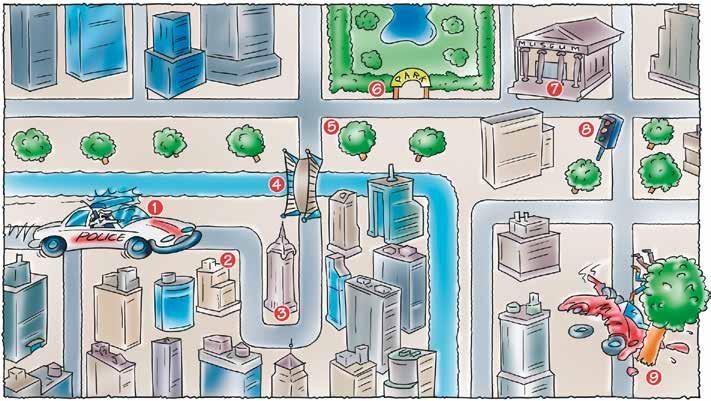
The police car goes (1) . It turns (2) . It goes (3) and (3) again. The police car crosses the (4) . It turns right around the (5) . The policeman passes the (6) and the (7) He goes (8) at the traffic lights. The thief’s car crashes into a (9)
Practise the sentences with your classmate.
7. Listen to the song.
What do they want to visit in one day?
Circle the right places.
1. Tower Bridge / Westminster Abbey
2. London Zoo / London Aquarium
3. Madame Tussauds / Hyde Park
4. Big Ben / The London Eye
Which directions did you hear? Tick the boxes.
O turn right O take the first street on the right
O go as far as the roundabout O go straight on
O take the first street on the left O turn left
Finished? Do this.
Fill in the puzzle.
1. We pick grandma up at the railway …
2. Nick went to the … to see the tigers and the gorillas.
3. In our village you can hear the … bells on Sunday morning.
4. When two roads make the shape of a cross it is called a …
5. The boys jump and dive into the …
6. I buy a book in the …
7. This King’s Day Tom sells his old toys at the children’s … 1 2 3 4
The word you can read under the arrow is
Finished? Find out.
In this picture you can see a lot of famous buildings. Do you know their names? Write the right numbers in the buildings. Choose from the list below. 1. Taj Mahal 2. Machu Picchu 3. The Great Wall of China

The Golden Gate Bridge
The Great Pyramid of Giza
Borobudur
The Sydney Opera House
The Blue Mosque
Excuse me sir, can you tell me the way?
Is it very near or is it far away?
We want to go to the swimming pool.
Because today we don’t want to go to school.
First you turn left and then you turn right. You pass the little signpost in black and white. Take good care and have a lot of fun. Use a little sunscreen against the hot sun!
Tick the right answer.
The Empire State Building is on 5th Avenue. O true O false
Listen again and repeat the phrases.
Jamie: Isn’t it terrific to be in New York! Everything is so big!
Sammy: Where shall we go?
Jamie: Let’s do some sightseeing in the morning.
Sammy: OK. I’d like to visit the Empire State Building. Let’s have a look at the map.
Jamie: We are here, in the city centre, in front of Central Park. We take the second street on the left. At the second crossroads we turn right.
Sammy: Right. Then we go straight on until we come to the Empire State Building.
Jamie: It’s between 34th and 33rd street on 5th Avenue. We’ll take the lift to the top!
Sammy: We’ll have a wonderful view of New York!
Repeat the text with a classmate.
4. Work in pairs.


One of you is Jamie, the other one is Sammy. Look at the pictures. Tell your classmate where you are. Use: in front of – next to –behind – on – opposite –under – above – near
5. Listen to the dialogue.
Circle the right answers.
A. Where are Bobby and his mum when they find out they have lost Bobby’s father? Bobby and his mum are at the entrance to a computer shop / a department store.
B. Is this the first time that Bobby’s father has got lost?
Yes, it is. / No, it isn’t.
Phrases to know
Ask for the way: Excuse me, sir / madam, can you tell me the way to…? Excuse me, could you tell me where the …. is please?

Show the way: go straight on turn left / right take the first / second / third street / on the right / left

Listen again and repeat the phrases.
Mother: I’m afraid we lost Daddy again. He always gets lost when we’re shopping!
Bobby: Where did we last see him?
Mother: In that computer shop near the railway station. How do we get there from this department store?
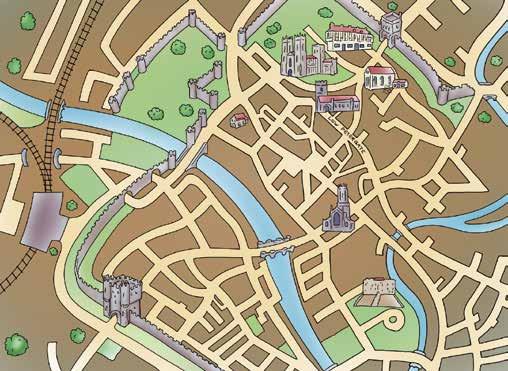
Bobby: Let’s ask somebody. Excuse me, could you tell me where the computer shop is, please?
Passer-by: Of course. At the store exit you turn left, then you pass a little market, and at the end there’s a computer shop. Next to a cinema and opposite the post office.
Bobby: Thank you.
Mother: We also passed a post office in a little side street with a church.
Bobby: Yes, it’s only a few minutes from here.
Repeat the text with a classmate.
Listen to Lenny. She will tell you what to do!
Finished? Do this.
Ann writes about her village in an e-mail project. Fill in the right words.
Choose from: next to – in front of – behind – across – in the middle of
I live in a nice little village in the Yorkshire Dales. Our school is the village. It is an old building.
On the corner of the main street there’s a little shop some old houses. the road there’s a post office.
The garage is the church, just outside the village.
Finished? Be creative.
A. Write about your own village or neighbourhood the way Ann did. You may use a dictionary. Use phrases like: next to in front of behind opposite in the middle of
B. Draw a small map of what you wrote. Work in pairs. Read your text to a classmate. Your classmate looks at the map. Are the map and the text correct?
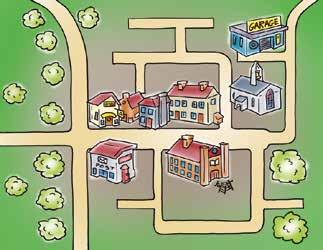
1. Sightseeing.
A. Where do the words fit? Fill in the table.
Choose from: a zoo – a souvenir shop – a department store – a cinema – a museum –a theme park – Madame Tussauds – a market – a clothes shop entertainment shopping
B. Do you know any more words? Add them to the table.
2. Read the text.
Which attraction do you like the most? Can you say why?
Write it down and circle the right word.
I like most, because it is interesting / funny / exciting / unusual / famous.
Nice to know Drive on the left: Unlike the rest of Europe, people in Britain drive on the left-hand side of the road. The cars have the driver’s seat on the right. You have to go clockwise at roundabouts.
London Zoo is an unforgettable experience for children! With 12,000 animals, you’re sure to discover plenty to entertain and inform. Don’t miss ‘Meet the Monkeys’, an exciting monkey walk-through experience or the new exhibit, ‘Into Africa’, where you will see some of Africa’s most unusual animals.

The London Eye is where you should go for the best views of London! The world’s largest observation wheel is 135 m (443 ft) high and is situated on the Southbank opposite the Houses of Parliament. On a clear day views are a stunning 40 km (25 miles) so you can see all of London at once!

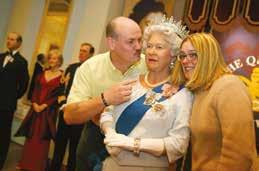
The Tower of London, was one of the most feared castles, as it was a place of execution and imprisonment. It is one of London’s oldest and most popular attractions, most famous for the Crown Jewels, the Bloody Tower and the black ravens!
Meet the rich and famous at Madame Tussauds Have your picture taken beside David Beckham, Prince Charles or Kylie Minogue. In the Grand Hall you can meet the Royal Family, and in the Chamber of Horrors you’ll find one of Jack the Ripper’s victims. You can even see Madame Tussaud herself at work.
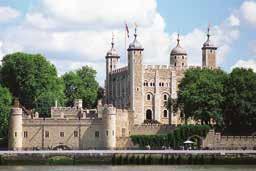
3. Read the phrases.
If you want to say something about a building or a place, you can say:it is tall / large it is famous / exciting
If you compare this with another building or place, you can say:It is taller than that building… when it is a short word It is more exciting than that place… when it is a longer word
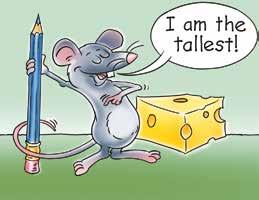
If there is no other building or place as tall as this one, you can say:It is the tallest building. when it is a short word It is the most exciting place when it is a longer word
Fill in the right form.
1. The Empire State building is than the Chrysler Building. (tall)
2. La Paz is the capital city in the world. (high)
3. The Singapore Flyer is a observation wheel than the London Eye. (high)
4. Is the view from the Empire State Building than the view from the Eiffel Tower? (wonderful)
5. In a special part of London Zoo called ‘Into Africa’ you can see the African animals. (unusual)
6. Is the Golden Gate Bridge in San Francisco than the Tower Bridge in London? (famous)
In the cartoon you see a car with a navigation system. Is a navigation system always useful when you want to find your way? Tick the right answer. A navigation system can be useful, but
O not if you go to another country.
O not if you don’t know your right from your left. O not if you wear glasses.
Your teacher will give you a map. Tick the buildings and places you can find.
O a post office O a swimming pool O a school O a department store
O a town hall O a supermarket O a police station O a bookshop
O a bank O a car park O a restaurant O a church
O a mosque O a cinema O a sports centre O a museum O a park O a railway station O a souvenir shop
Work in pairs. Choose who will play the tourist and who will play the passer-by. The tourist asks the way to a building on the map. Find out what you need to do and say. Use the Phrases to know Unit 4 lesson 3.
Tourist: asks where the … (post office, town hall, ...) is.
Passer-by: says he / she knows and describes the way to …
Tourist: draws this way on his / her map.
Tourist: repeats the way: First I …
Passer-by: answers ‘ That’s it!’ if it’s correct or describes the way again if it’s not correct.
Tourist: says thank you.
Passer-by: says you’re welcome.
One of you plays the tourist, and the other one plays the passer-by. Act out your conversation.
Finished? Do this.
A. Draw a line between the picture and the right text. road signs and traffic signals
means...
Children crossing the road
No parking
Turn right only No stopping Pass on the right hand side The road crosses the railway track One way Slippery road No entry No turning Stop junction ahead Straight ahead Left hand curve Danger: be careful! Crossroads
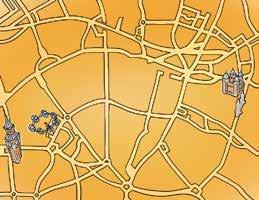
B. Design your own road sign. What does your road sign mean?
Finished? Be creative.
Choose a famous monument or attraction from the map of London city centre. Make a holiday brochure. Use pictures from magazines or the internet.
Search for information and write a short text. Also describe how you can get to your sight by underground or bus.
Ask for the way Answers: Excuse me, sir / madam, can you tell Sure. me the way to…? Of course. Excuse me, could you tell me where I’m sorry. I can’t help you. I’m a stranger the …. is please? here myself.
If you want to say something about a building or a place, you can say: It is tall. It is exciting. If you compare this with another building or place, you can say: It is taller than that building. when it is a short word It is more exciting than that place. when it is a longer word
If there is no other building or place as tall as this one, you can say: It is the tallest building. when it is a short word It is the most exciting place. when it is a longer word
How to explain the way: go straight on turn left / right take the first / second / third street / turning on the right / left you come to…
How to use to go Today: I go shopping. you go shopping. he / she goes shopping.
How to use it
Yesterday: I went shopping. you went shopping. he / she went shopping.
I have a car. It goes very fast. It went very fast. You use it when the thing you are talking about is not a person.
Words to know
a big city een grote stad a view een uitzicht a waste of time tijdverspilling across tegenover attraction attractie behind achter bookshop boekwinkel car park parkeerterrein
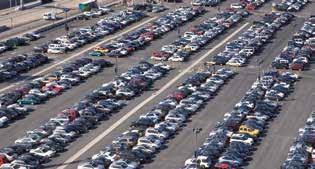
museum museum near dichtbij next to naast pavement stoep railway station treinstation signpost wegwijzer souvenir shop souvenirwinkel square plein
church kerk cinema bioscoop city centre stadscentrum city map stadsplattegrond corner hoek
swimming pool zwembad the post office het postkantoor the town hall Het gemeentehuis to cross the road de straat oversteken
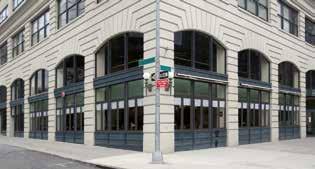

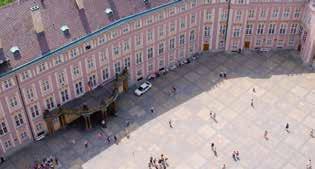
crossroads kruispunt department store warenhuis first, second, third eerste, tweede, derde get a taxi een taxi nemen impossible onmogelijk in front of voor mosque moskee
to discover ontdekken to go sightseeing bezichtigen to read a map kaartlezen to show the way de weg wijzen trip uitstapje turning draaien, afslaan useful handig village dorp
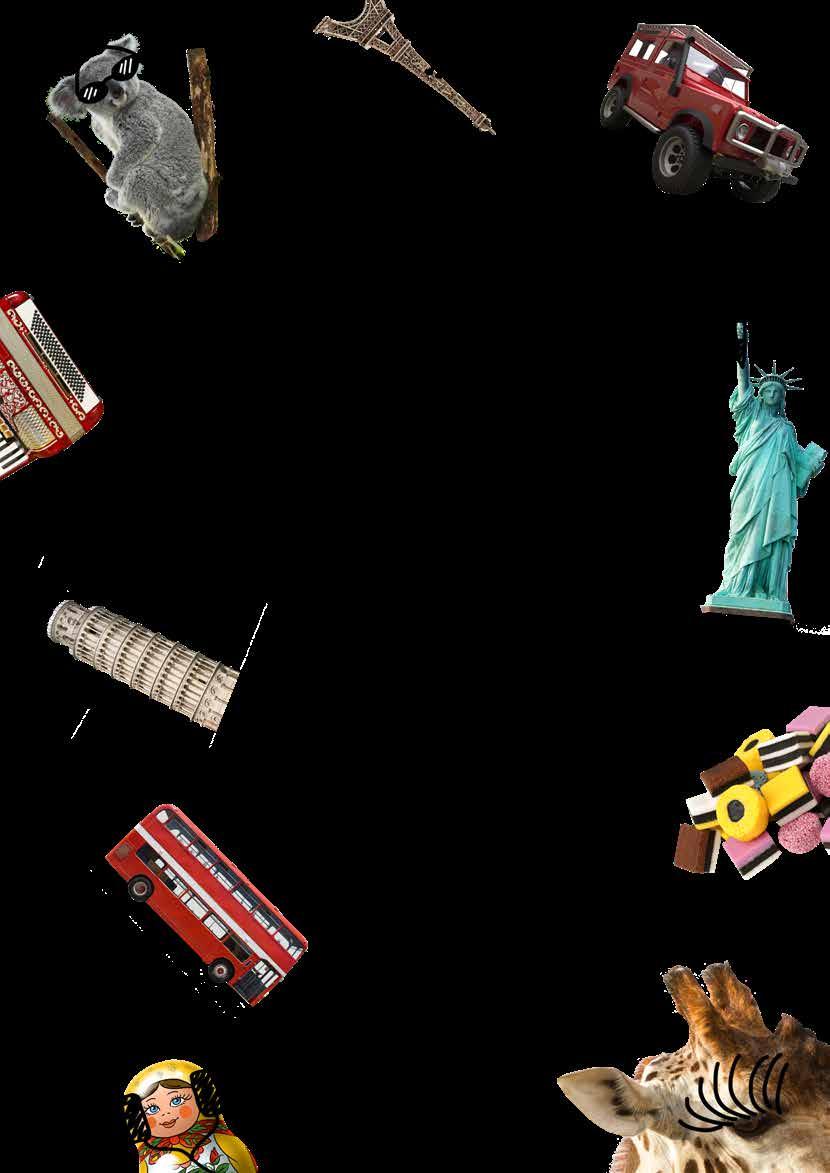

Lesdoelen les 1
Aan het eind van de les kunnen de leerlingen:
• informatie over allerlei soorten winkels halen uit de film, het lied en de dialoog en vragen daarover beantwoorden; • vragen hoeveel iets kost en zeggen hoeveel iets kost.
Aan het eind van de les kennen de leerlingen:
• de leswoorden: shopping centre, dairy, butcher’s, chemist’s, stationer’s, toy shop, clothes shop, special offer, bargain, expensive.
Benodigde materialen:
• opdracht 6: kopieerblad 2.01;
• ster-opdracht 2: groot vel papier, supermarkttijdschriften / reclamefolders met plaatjes van eten en drinken, lijm, schaar, schrijfmateriaal;
• afsluitende opdracht: kopieerblad 2.02.
Introductie les 1 (10 min) Kies in het lesmenu welke onderdelen passen bij jouw groep.
Introductieopdracht – opdracht 1 verwerken
Bij opdracht 1 zie je een tekening van een winkelcentrum met verschillende winkels. De Engelse woorden voor de winkels staan erbij. De leerlingen geven aan welke winkels er bij hen in de buurt te vinden zijn. De winkels die je op de afbeelding ziet, zijn: department store (warenhuis), greengrocer’s (groentenman), bakery (bakker), butcher’s (slager), chemist’s (apotheek), dairy (zuivelwinkel), clothes shop (kledingwinkel), stationer’s (kantoorboekhandel), supermarket (supermarkt), bookshop (boekhandel), souvenir shop (souvenirwinkel), toyshop (speelgoedwinkel) en gift shop (cadeauwinkel). Zijn er woorden bij die op het Nederlandse woord met dezelfde betekenis lijken? Welke? Laat de leerlingen ze benoemen.
Let op: verwar dairy niet met het Engelse woord diary (agenda/dagboek) dat er erg op lijkt!
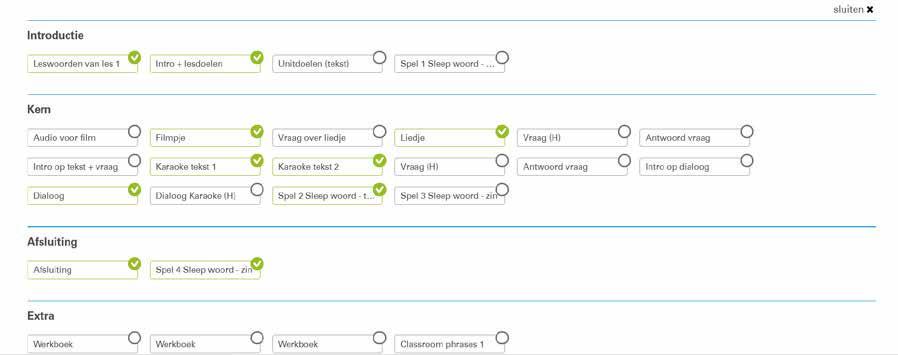
Kern les 1 (30 min)
De leerlingen maken tijdens het verwerken de opdrachten 2 t/m 6. Na het bekijken van de film maken ze opdracht 2, gevolgd door opdracht 3 na het lied. Opdracht 4 hoort bij de leestekst en opdracht 5 en 6 maken de leerlingen na de dialoog.
1. Beantwoord de vragen.
2. A. Kies de juiste antwoorden.
B. Trek lijnen van de vragen naar de juiste antwoorden.
3. Kies het juiste antwoord.
4. Kies het juiste antwoord.
Vertalingen van vragen en antwoorden: Engels
Audio Let’s watch the film. The film is about two children walking in a shopping centre. They are going to all kinds of shops but almost forget something important…
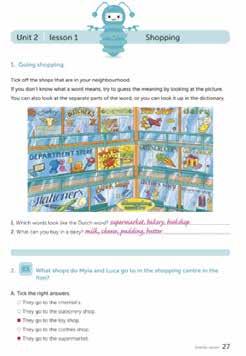
5. Herhaal de dialoog in tweetallen.
6. Maak je eigen dialoog en acteer jullie dialoog (via kopieerblad).
Nederlands
We gaan film kijken. De film gaat over twee kinderen die in een winkelcentrum lopen. Ze gaan naar allerlei winkels maar bijna vergeten ze iets belangrijks…
Vraag [geïntegreerd in film] [geïntegreerd in film]
Antwoord [eigen antwoord] [eigen antwoord]
Vraag What’s the girl’s problem?
Wat is het probleem van het meisje?
Antwoord She’s a shopaholic: she can’t stop shopping. Ze is verslaafd aan winkelen: ze kan niet meer stoppen.
Vraag What do you think this text is about?
Antwoord The text is about the Edinburgh World Shop where fair trade goods are sold.
Spreekopdracht bij de dialoog – opdracht 5
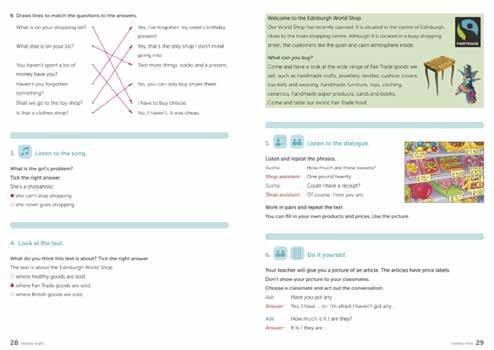
Waar gaat de tekst over denk je?
De tekst gaat over de Edinburgh World Shop waar fairtrade-spullen worden verkocht.
De leerlingen herhalen de dialoog en oefenen hoe ze eenzelfde soort gesprek kunnen voeren. Dit doen ze door hun eigen producten en prijzen in de dialoog te verwerken.
Extra uitleg bij opdracht 6
De leerlingen doen een finding identical pairs-oefening. Op kopieerblad 2.01 vind je vijftien plaatjes van verschillende producten en hun prijs. Kopieer dit blad twee keer en geef elke leerling een plaatje. Zorg ervoor dat elk plaatje twee keer
is uitgedeeld. De leerlingen mogen het plaatje niet laten zien aan hun klasgenoten. Vervolgens proberen ze door het stellen van vragen, hun identieke afbeelding te vinden. Vragen en antwoorden die centraal staan, zijn: Have you got a… (necklace/cauliflower/sharpener)? Yes, I have. of I’m afraid I haven’t got a …. How much is it / are they?
It is / They are (fourteen pounds and fifty pence / seventy pence).
Bij ster-opdracht 1 maken de leerlingen een puzzel met de leswoorden. Bij ster-opdracht 2 maken de leerlingen een poster voor een supermarkt. Daarop schrijven ze de verschillende afdelingen (butcher’s, dairy, bakery enzovoorts) en plakken ze plaatjes van de producten die deze afdelingen in de aanbieding hebben. Ze beschrijven de producten en zetten ook de prijs erbij.
Afsluiting les 1 (10 min)
Na het verwerken volgt de afsluitende opdracht.
Afsluitende opdracht
De leerlingen maken een kruiswoordpuzzel met de Engelse woorden voor verschillende winkels. Je deelt hiervoor kopieerblad 2.02 uit. Laat de leerlingen in tweetallen werken en na afloop een zin maken met het woord dat ze van boven naar beneden lezen. Als ze tijd over hebben, kunnen ze proberen zelf een kruiswoordpuzzel te maken met de woorden van deze les.
Aantekeningen
Aan het eind van de les kunnen de leerlingen:
• informatie over winkelen halen uit de film, de leestekst en het lied en vragen daarover beantwoorden;
• vragen en zeggen hoeveel iets kost;
• meezingen met het lied over winkelen.
Aan het eind van de les kennen de leerlingen:
• de leswoorden: shopkeeper, shop assistant, customer, shop window, to pay cash, to pay by credit card, queue, almost, probably, free.
Benodigde materialen:
• afsluiting les: kopieerblad 2.19;
• ster-opdracht 1: kopieerblad 2.03;
• ster-opdracht 2: vel papier, schrijf- / tekenmateriaal, lijm, schaar, tijdschriften / reclamefolders met afbeeldingen van fairtrade-producten.
Introductie les 2 (10 min)
Kies in het lesmenu welke onderdelen passen bij jouw groep.
Introductieopdracht – opdracht 1 verwerken
Vraag de leerlingen of ze nog weten wat je moet zeggen als je wilt weten of een bepaald product in de winkel te koop is (Have you got any …) en hoe duur het is (How much is it / are they?). Wijs de leerlingen vervolgens op de illustratie van winkels bij opdracht 1. Neem de woorden voor de winkels met de leerlingen door. Laat de leerlingen de producten die boven de illustratie staan, bij de juiste winkel invullen. Leg van tevoren uit dat er twee woorden overblijven (dress en trousers) die niet passen bij de genoemde winkels. Weten de leerlingen in welke winkel je deze producten wel kan kopen (a clothes shop)?
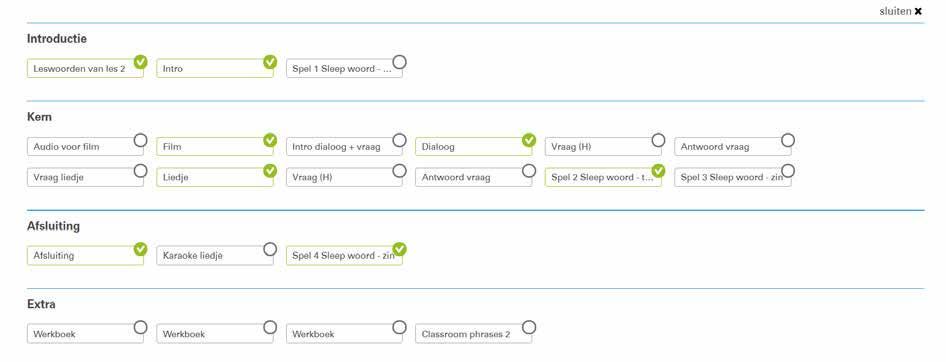
Kern les 2 (30 min)
De leerlingen maken tijdens het verwerken de opdrachten 2 t/m 7. Hierbij kijken en luisteren ze nogmaals naar de film en het lied uit les 1. Opdracht 2 heeft betrekking op de film. Naar aanleiding van de dialoog maken de leerlingen opdracht 3 en 4. Opdracht 5 is een grammatica-opdracht en opdracht 6 is een woordenschatopdracht. Opdracht 7 volgt na het lied. In les 2 is het lied op het digibord voorzien van ondertiteling zodat je met de leerlingen kunt meezingen (zie ook kopieerblad 2. 19).
2. A. Vul de tabel in. B. Vul de juiste woorden in.
4. Vul de juiste woorden in.
3. Kies het juiste antwoord.
6. Maak de zin af met het juiste woord.
5. Vul de juiste werkwoorden in.
7. A. Kies de juiste antwoorden. B. Maak eigen zinnen.
*1. Zoek de verschillen (op kopieerblad).
*2. Maak een advertentie voor een nieuwe winkel naar keuze.
Vertalingen van vragen en antwoorden: Engels Nederlands Film
Audio
Myla needs to buy a birthday present. When did you last buy a present for someone? Tell your classmate about the last present you bought. Who was it for?
Myla moet een verjaardagscadeau kopen. Wanneer heb jij voor het laatst een cadeau gekocht voor iemand? Vertel aan je klasgenoten wat je had gekocht en voor wie.
Vraag [geïntegreerd in film] [geïntegreerd in film]
Antwoord [eigen antwoord] [eigen antwoord]
Vraag How do Mr and Mrs MacDuff pay? Hoe betalen dhr. en mevr. MacDuff?
Antwoord They don’t pay at all. Ze betalen helemaal niet.
Vraag Which items do you hear in the song?
Antwoord The items you hear are: games, clothes, jeans, sneakers and sweaters.
Welke artikelen hoor je in het lied?
Je hoort: spellen, kleding, spijkerbroeken, sportschoenen en truien.
Extra uitleg bij opdracht 5 Je bespreekt de taalfunctie ‘vragen en zeggen hoeveel iets kost’ met de leerlingen. Wijs de leerlingen op de zinnen onder Phrases to know waarmee je kunt vragen hoe duur iets is. Vertel vervolgens dat je de zin moet aanpassen als je het over meerdere producten tegelijk hebt: How much are they? Bespreek daarna de aanwijzende voornaamwoorden this en these: dit zijn allebei woorden om aan te geven dat iets dichtbij je is. This is enkelvoud en these is meervoud. Hierna maken de leerlingen opdracht 5.
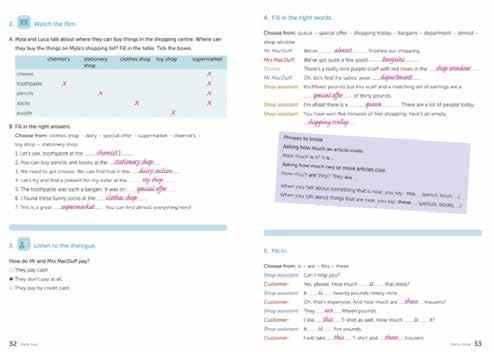
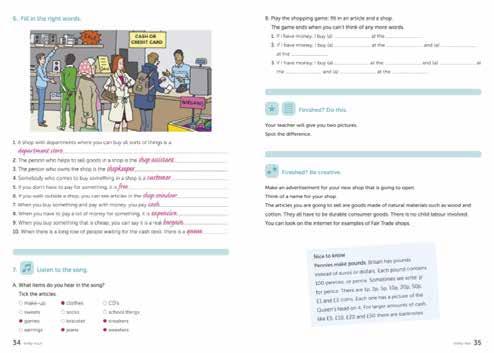
Bij ster-opdracht 1 gebruik je kopieerblad 2.03. Hierop staan twee afbeeldingen van een winkelstraat. De leerlingen moeten de verschillen tussen de twee afbeeldingen ontdekken. De verschillen omcirkelen ze én vertellen ze aan elkaar. Daarna omschrijven ze de verschillen ook.
Bij ster-opdracht 2 gaan de leerlingen een advertentie voor hun nieuwe winkel maken waarin ze alleen biologische, duurzame en fairtrade-producten verkopen. Ze bedenken een naam voor hun winkel en schrijven die op hun advertentie. Ook schrijven ze op welke producten ze verkopen, hoe duur de producten zijn en zoeken er plaatjes bij in tijdschriften of op internet.
les 2 (10 min)
Na het verwerken kun je als afsluiting het lied nogmaals met de leerlingen zingen. Gebruik kopieerblad 2.19 als je de songtekst op papier wilt hebben.
AantekeningenAan het eind van de les kunnen de leerlingen:
• de korte /o/ in woorden als shopping en stop correct uitspreken;
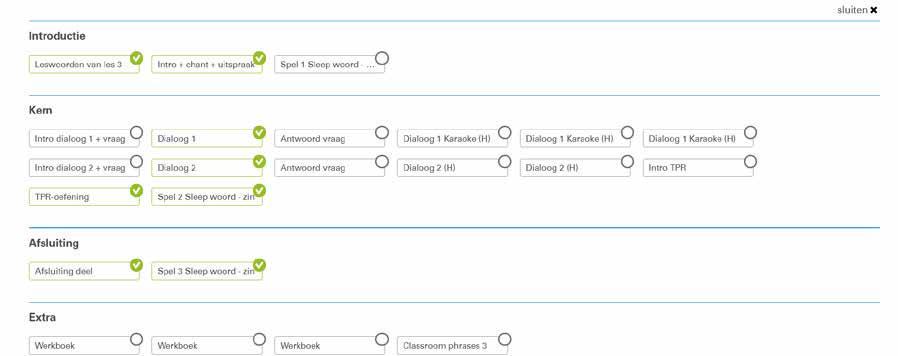
• dialogen naspreken;
• vragen om een tegoedbon en een bonnetje in een winkel;
• vragen of het product dat ze kopen ingepakt kan worden.
Aan het eind van de les kennen de leerlingen:
• de leswoorden: to order, to spend, to return, to wrap up, to carry, to try on, to fit, wallet, refund, receipt.
Benodigde materialen:
• ster-opdracht 2: kopieerblad 2.05;
• afsluitende opdracht: kopieerblad 2.04.
Introductie les 3 (10 min)
Kies in het lesmenu welke onderdelen passen bij jouw groep.
De leerlingen zeggen bij opdracht 1 de chant na over iets kopen in een winkel. In deze chant staat de /o/-klank centraal in woorden als shopping, stop, clock, shock enzovoort. Deze /o/ klinkt bijna als de /a/ in het Nederlandse woord ‘sap’. Deze klank kun je het beste maken als je een beetje glimlacht. Je lippen zijn dan gespreid.
Kern les 3 (30 min)
De leerlingen maken tijdens het verwerken de opdrachten 2 t/m 7. De leerlingen luisteren in deze les naar twee verschillende dialogen. Hier horen de opdrachten 2, 3, 4, 5 en 6 bij. De laatste opdracht 7 is een TPR oefening waarbij je het digibord nodig hebt.
1. Luister en herhaal.
2. Kies het juiste antwoord.
3. Herhaal de dialoog in tweetallen.
5. Vul het juiste antwoord in.
6. Herhaal de dialoog in tweetallen.
4. Maak je eigen dialoog en acteer jullie dialoog.
7. Kijk en luister naar Regis.
*1. A. Vul de juiste woorden in. B. Noem zoveel mogelijk woorden op die je nog weet.
Vertalingen van vragen en antwoorden: Engels Nederlands
Dialoog 1
Vraag What have Alfy and his mother bought? Wat hebben Alfy en zijn moeder gekocht? Antwoord Alfy and his mother have bought a T-shirt. Ze hebben een T-shirt gekocht.
Dialoog 2
Vraag How do the girls pay? Hoe betalen de meisjes?
Antwoord They pay by credit card. Met een creditkaart.
Spreekopdracht bij de dialoog – opdracht 4 De leerlingen hebben de dialoog bij opdracht 3 herhaald en in opdracht 4 oefenen hoe ze eenzelfde soort gesprek kunnen voeren. Dit doen ze door hun eigen versie van de dialoog te maken. Ze bedenken hun eigen kleuren, kleding en maat.
Extra uitleg bij opdracht 6
Eerst spreken de leerlingen de dialoog na. Daarna lees je met de leerlingen de zinnen onder de Phrases to know over de taalfuncties ‘vragen stellen aan een winkelbediende’ en ‘vragen en zeggen hoeveel iets kost’. Benadruk dat de vorm Could I have …? iets beleefder is dan Can I have …?. Bespreek dat er twee manieren zijn om te vragen hoeveel iets kost: How much is it? en How much does it cost? Neem vervolgens de zinnen door die je gebruikt om te vragen of je een artikel kunt terugbrengen en of het mogelijk is om je geld terug te krijgen.
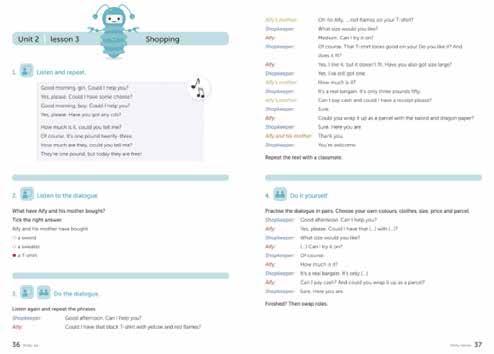
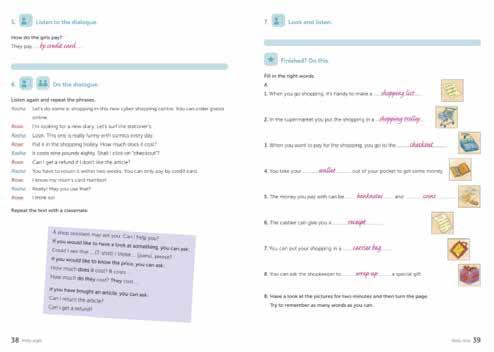
TPR oefening – opdracht 7
De leerlingen laten door middel van gebaren zien dat ze begrijpen wat de co-teacher bedoelt. Als de leerlingen de handeling hebben uitgevoerd, laat de co-teacher zien wat er gevraagd werd.
Aan het eind van de les kunnen de leerlingen:
• vragen of een winkel een bepaald artikel verkoopt en hoeveel het kost;
• een winkelbediende om een bonnetje, een tasje of een tegoedbon vragen;
• een winkelbediende vragen het artikel in te pakken;
• vragen naar de openingstijden van een winkel.
Aan het eind van de les kennen de leerlingen:
• de leswoorden: discount, article, parcel, size, large, medium, small, to forget, to show, to sell, careful, for example.
Benodigde materialen:
• ster-opdracht 2: kopieerblad 2.07.
Introductie les 4 (10 min)
Kies in het lesmenu welke onderdelen passen bij jouw groep.
Introductieopdracht – opdracht 1 verwerken
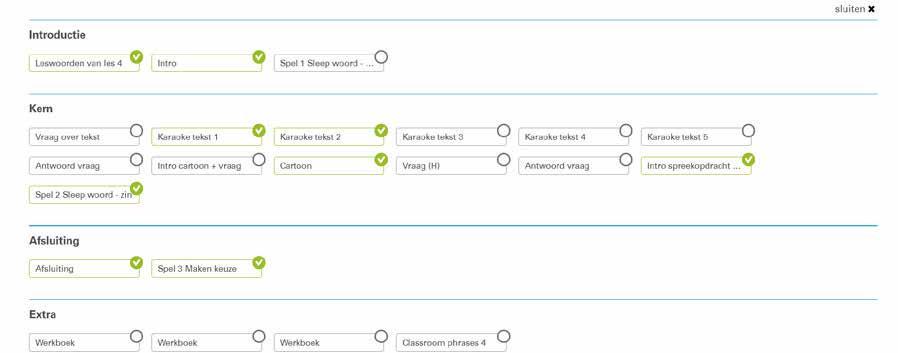
De leerlingen schrijven bij opdracht 1 de juiste woorden in de zinnen, waarbij ze eventueel woorden kunnen opzoeken in de woordenlijst van les 5. Vervolgens strepen ze de woorden door in de woordzoeker en maken ze met de overgebleven letters een zin.
Kern les 4 (30 min)
De leerlingen maken tijdens het verwerken de opdrachten 2 t/m 7. De leerlingen lezen een tekst, kijken naar een cartoon en doen een spreekopdracht. Opdracht 2 en 3 hebben betrekking op de leestekst. Naar aanleiding van de cartoon maken de leerlingen opdracht 4. Opdracht 5, 6 en 7 vormen samen de spreekopdracht.
2. Kies de juiste antwoorden.
3. Bedenk een dialoog die past bij de gekozen winkel, in tweetallen.
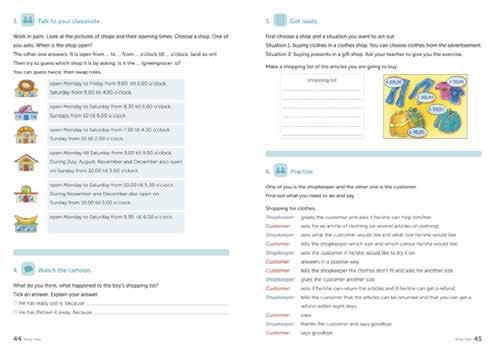
5. Maak een lijstje met dingen die je gaat kopen (op kopieerblad).
6. Oefen de dialoog, in tweetallen.
4. Bedenk en schrijf op wat je hebt bedacht.
7. Acteer jullie dialoog.
*1. Vul de juiste woorden in.
*2. Los de supermarkt puzzel op (op kopieerblad).
Vertalingen van vragen en antwoorden:
Engels
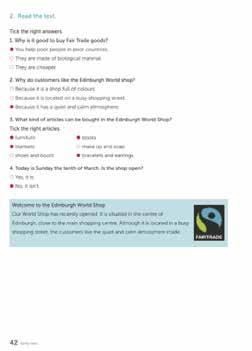
Vraag Why is it good to buy fair trade goods?
Nederlands
Waarom is het goed om fairtrade-spullen te kopen?
Antwoord You help poor people in poor countries. Dan help je mensen in arme landen.

Cartoon
Vraag What happened to the boy’s shopping list, according to you?
Antwoord Well, that’s up to you! I think ...
Wat is er volgens jou gebeurd met het boodschappenlijstje van de jongen?
Dat is aan jou! Ik denk …
Je bespreekt de taalfunctie ‘vragen naar en zeggen van de openingstijden van een winkel’ met de leerlingen. Lees samen de zinnen door onder Phrases to know. Geef een voorbeeld van een vraag en antwoord over de openingstijden, bijvoorbeeld: When is the supermarket/shop open? The supermarket is open from Monday till Friday from 8 o’clock till 8 o’clock.
Benadruk dat ‘van-tot’ in het Engels dus from-till is. Laat de leerlingen in tweetallen oefenen met de zinnen in opdracht 3. Ze vragen elkaar wanneer één van de winkels uit het rijtje open is en antwoorden met de in de opdracht gegeven openingstijden.
Spreekopdracht – opdracht 5, 6 en 7
De leerlingen gaan de geleerde stof nu in de praktijk brengen door in tweetallen een dialoog te bedenken en uit te voeren. In deze les gaat de dialoog over hoe je in het Engels iets in een winkel koopt. De ene leerling is de klant en de andere leerling is de winkeleigenaar. De leerlingen bereiden zelf de dialoog voor in opdracht 5 en 6. In opdracht 5 kiezen ze de winkel waar ze iets willen kopen en bedenken ze wat ze willen kopen. Deze informatie helpt bij het samenstellen van de dialoog in opdracht 6. Bij opdracht 7 voeren de leerlingen de dialoog ook daadwerkelijk uit.
Bij ster-opdracht 1 raden de leerlingen het juiste product aan de hand van een Engelse omschrijving. Bij ster-opdracht 2 gebruik je kopieerblad 2.07. Hierop staat de Supermarket mix-up puzzel: Bob, Mandy, Sue en Karim zijn er na het afrekenen achter gekomen dat al hun boodschappen door elkaar liggen. De leerlingen proberen uit te vinden welke producten er op het boodschappenlijstje van elk van de vier kinderen staan, door de gegeven aanwijzingen in het Engels op te volgen.
Afsluiting les 4 (10 min)
Na het verwerken volgt de afsluitende opdracht.
Afsluitende opdracht
De leerlingen spelen hun eigen dialoog uit opdracht 7 na voor de klas.
Aan het einde van de les kunnen de leerlingen:
• vragen beantwoorden na het beluisteren van een dialoog;
• vragen beantwoorden over de leswoorden van deze unit;
• vragen beantwoorden na het lezen van een tekst;
• de grammatica van deze unit op de juiste manier gebruiken.
Benodigde materialen:
• spullen voor een winkeltje (bij Afsluiting).
Introductie toetsles 5 (10 min)
Kies in het lesmenu welke onderdelen passen bij jouw groep.
In de toetsles van unit 2 worden alle leswoorden en taal- en grammaticaregels herhaald uit de voorgaande lessen. Je bekijkt samen de Phrases to know en de Words to know of je laat de leerlingen deze zelfstandig herhalen. Ook komen de verschillende grammaticaschermen op het digibord aan bod om de taalregels en -afspraken nog eens te bespreken.
Nog beter is het om de grammatica ook al in eerdere lessen in te zetten.
Vragen en zeggen hoeveel iets kost (enkelvoud en meervoud). Bijvoorbeeld: How much is it? It is … How much are they? They are ...
Het gebruik van this en these. Bijvoorbeeld: Then you talk about something that is near, you say : this … (pencil, book, …) When you talk about things that are near, you say: these … (pencils, books, …).
Vragen stellen aan een winkelbediende. Bijvoorbeeld: Could I have that/those ... (T-shirt, jeans, book, CD, …) please? If you would like to know the price you can ask: How much does it cost? It costs … How much do they cost? They cost … Can I return the article? Can I get a refund?
Vragen stellen over de openingstijden en antwoord geven. Bijvoorbeeld: When is the shop open? The answer can be: It is open from … (day of the week) till … (day of the week) from … o’clock till … o’clock. In … (months) we are also open on Sundays.

Kern toetsles 5 (25 min)
De leerlingen maken de individuele toets. Bij opdracht 1 hoort altijd een luistertekst die op het digibord klassikaal is te beluisteren. Je kunt deze tekst meerdere keren laten horen. De toets in unit 2 betreft 8 opdrachten. De toetsnormering staat op de methodestartpagina onder Leerlijnen en doelen.
Meer dan 32 punten goed cijfer 8 / 10
Tussen 23 en 32 punten voldoende cijfer 5.5 / 7.5
Minder dan 23 punten niet voldoende (nog een keer oefenen) cijfer 5.5 en lager
Snellere leerlingen kunnen de extra toetsopdracht maken, zie de methodestartpagina onder Opdrachten ‘Test – an extra question’, of zie de verwerkingssoftware via Extra exercises waar ook een extra puzzel staat.
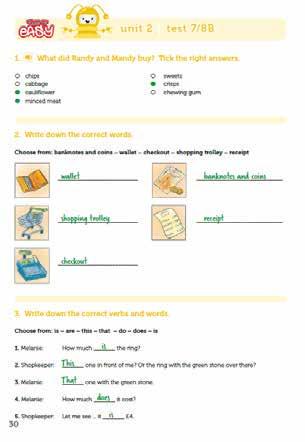
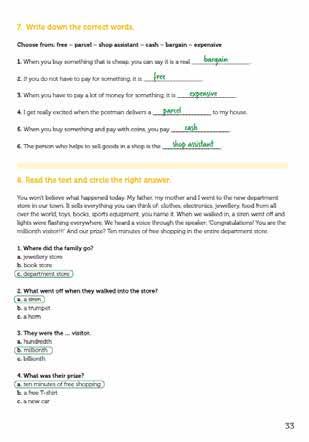
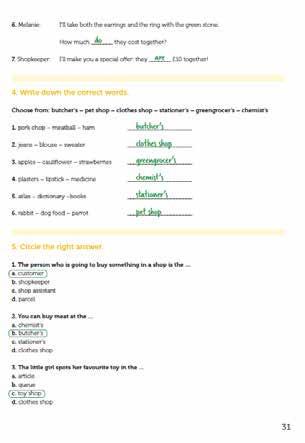
toetsles 5 (10 min)

Je sluit de unit af met één of twee Taalspelen:
• Je speelt met de leerlingen het spel Can I get a refund? Elke leerling neemt een winkel in gedachten. Je vraagt steeds aan een van hen of je een bepaald artikel bij hen kan ruilen. Leerkracht: Hello, I’ve got a bottle of perfume. I don’t like perfume. Can I get a refund here? Leerling: Yes, you can. Of: Leerkracht: Hello, I’ve got a sweater. I don’t like sweaters. Can I get a refund here? Leerling: No, you can’t. This is a toy shop. Leerkracht: Oh. Then where can I get a refund? Leerling: At the clothes shop.
• Toon het scherm op het digibord en vertel de leerlingen dat ze met de hele groep/groepjes een winkelspel gaan spelen (Shop till you drop). Laat een aantal leerlingen in verschillende hoeken van de klas een winkeltje opstellen (met een tafeltje en eventueel wat voorwerpen). Ze mogen zelf bedenken welk type winkel ze beheren. Laat de overige leerlingen in tweetallen winkelen. Ga eventueel eerst zelf bij de verschillende winkels langs. Stimuleer de klanten om te vragen naar een bonnetje, een tegoedbon, of om te informeren of het artikel geruild of ingepakt kan worden.
Extra: voorbereiden op unit 3
In de volgende les (unit 3 - les 1) is er voor de introductieopdracht niets nodig.
Aantekeningen

1. Going shopping.
Tick off the shops that are in your neighbourhood.
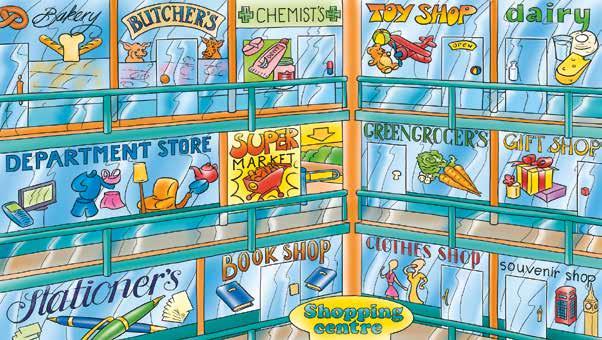
If you don’t know what a word means, try to guess the meaning by looking at the picture. You can also look at the separate parts of the word, or you can look it up in the dictionary.
1. Which words look like the Dutch word?
2. What can you buy in a dairy?
2. What shops do Myla and Luca go to in the shopping centre in the film?
A. Tick the right answers.
O They go to the chemist’s.
O They go to the stationery shop.
O They go to the toy shop.
O They go to the clothes shop.
O They go to the supermarket.
B. Draws lines to match the questions to the answers.
What is on your shopping list?
What else is on your list?
You haven’t spent a lot of money have you?
Haven’t you forgotten something?
Yes, I’ve forgotten my sister’s birthday present!
Yes, that’s the only shop I don’t mind going into.
Two more things: socks and a present.
No, you can only buy shoes there.
I have to buy cheese. Is that a clothes shop?
Shall we go to the toy shop?
No, I haven’t. It was cheap.
3. Listen to the song.
What is the girl’s problem?
Tick the right answer. She’s a shopaholic: O she can’t stop shopping. O she never goes shopping.
4. Look at the text.
What do you think this text is about? Tick the right answer.
The text is about the Edinburgh World Shop
O where healthy goods are sold.
O where Fair Trade goods are sold.
O where British goods are sold.
Our World Shop has recently opened. It is situated in the centre of Edinburgh, close to the main shopping centre. Although it is located in a busy shopping street, the customers like the quiet and calm atmosphere inside.
Come and have a look at the wide range of Fair Trade goods we sell, such as handmade crafts, jewellery, textiles, cushion covers, blankets and weaving, handmade furniture, toys, clothing, ceramics, handmade paper products, cards and books. Come and taste our exotic Fair Trade food.
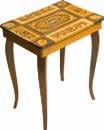

Listen and repeat the phrases.
Susha: How much are these sweets?
Shop assistant: One pound twenty.
Susha: Could I have a receipt?
Shop assistant: Of course. Here you are.
Work in pairs and repeat the text. You can fill in your own products and prices. Use the picture.
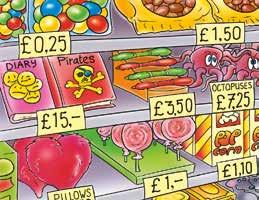
Your teacher will give you a picture of an article. The articles have price labels. Don’t show your picture to your classmates.
Choose a classmate and act out the conversation.
Ask: Have you got any ...
Answer: Yes, I have ... or: I’m afraid I haven’t got any ...
Ask: How much is it / are they?
Answer: It is / they are ...
Finished? Do this.
Read the sentences and look at the picture.
Fill in the crossword on the next page.
1. Shop where you can buy souvenirs.
2. Shop where meat can be bought.

3. Shop where clothes are sold.

4. Shop with all sorts of departments where you can buy all sorts of things.






5. Shop where bread is sold.


6. Shop where you can buy pens, diaries and paper. 7. Shop where vegetables are sold.
8. Building where you can buy stamps. 9. Shop where medicine, plasters and bandages are sold. 10. Shop where cheese and milk can be bought. 1. 2. 3. 4. 5. 6. 7. 8. 9. 10.
The word you can read under the arrow is:
Finished? Be creative.
Make a poster for a supermarket. There are different departments such as the butcher’s, the dairy, the bakery, ... Which articles are on offer? Cut out pictures of articles and stick them onto a large piece of paper. Describe the articles. Don’t forget the prices!
1. Fill in the articles under the right shops.
Choose from: cauliflower – medicine – ruler – beef – cheese – toothpaste – meatballs – pork chops –dress – vegetables – stapler – yogurt – cucumber – diary – plaster – trousers – milk
Two articles can only be bought in another shop. Which articles are they? A and . In which shop can you buy these articles? In a .
Do you know any other articles that you can buy in these shops? Write them down.
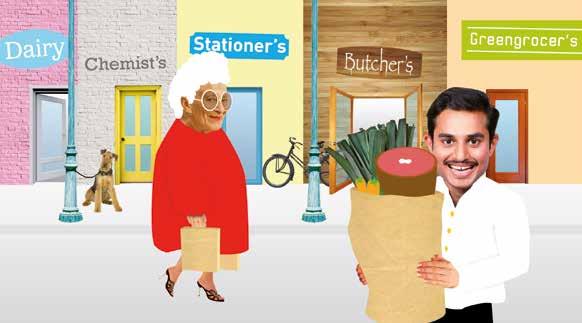
2. Watch the film.
A. Myla and Luca talk about where they can buy things in the shopping centre. Where can they buy the things on Myla’s shopping list? Fill in the table. Tick the boxes.
chemist’s stationery shop clothes shop toy shop supermarket cheese toothpaste pencils socks puzzle
B. Fill in the right answers. Choose from: clothes shop – dairy – special offer – supermarket – chemist’s –toy shop – stationery shop
1. Let’s see, toothpaste at the
2. You can buy pencils and books at the 3. We need to get cheese. We can find that in the 4. Let’s try and find a present for my sister at the 5. The toothpaste was such a bargain. It was on . 6. I found these funny socks at the . 7. This is a great . You can find almost everything here!
3. Listen to the dialogue.
How do Mr and Mrs MacDuff pay?
O They pay cash.
O They don’t pay at all.
O They pay by credit card.
Choose from: queue – special offer – shopping trolley – bargains – department – almost –shop window
Mr MacDuff: We’ve finished our shopping.
Mrs MacDuff: We’ve got quite a few good .
Donna: There’s a really nice purple scarf with red roses in the . Mr MacDuff: OK, let’s find the ladies’ wear .
Shop assistant: It’s fifteen pounds but this scarf and a matching set of earrings are a of thirty pounds.
Shop assistant: I’m afraid there is a . There are a lot of people today.
Shop assistant: You have won five minutes of free shopping: here’s an empty .
Asking how much an article costs:How much is it? It is ... Asking how much two or more articles cost:How much are they? They are …
When you talk about something that is near, you say : this ... (pencil, book, ...)When you talk about things that are near, you say: these .... (pencils, books, ...)
Choose from: is – are – this – these
Shop assistant: Can I help you?
Customer: Yes, please. How much that dress?
Shop assistant: It twenty pounds ninety-nine.
Customer: Oh, that’s expensive. And how much are trousers?
Shop assistant: They fifteen pounds.
Customer: I like T-shirt as well. How much it?
Shop assistant: It five pounds.
Customer: I will take T-shirt and trousers.
6. Fill in the right words.
1. A shop with departments where you can buy all sorts of things is a
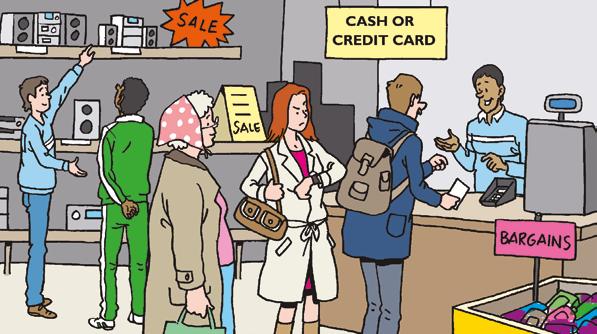
2. The person who helps to sell goods in a shop is the 3. The person who owns the shop is the 4. Somebody who comes to buy something in a shop is a 5. If you don’t have to pay for something, it is 6. If you walk outside a shop, you can see articles in the 7. When you buy something and pay with money, you pay 8. When you have to pay a lot of money for something, it is 9. When you buy something that is cheap, you can say it is a real 10. When there is a long row of people waiting for the cash desk, there is a 7. Listen to the song.
O clothes
O socks O bracelet O jeans O
school things
sneakers
sweaters
B. Play the shopping game: fill in an article and a shop.
The game ends when you can’t think of any more words.
1. If I have money, I buy (a) at the
2. If I have money, I buy (a) at the and (a) at the
3. If I have money, I buy (a) at the and (a) at the and (a) at the
Finished? Do this. Your teacher will give you two pictures. Spot the difference.
Finished? Be creative.
Make an advertisement for your new shop that is going to open.
Think of a name for your shop. The articles you are going to sell are goods made of natural materials such as wood and cotton. They all have to be durable consumer goods. There is no child labour involved. You can look on the internet for examples of Fair Trade shops.
Nice to know
Pennies make pounds. Britain has pounds instead of euros or dollars. Each pound contains 100 pennies, or pence. Sometimes we write ‘p’ for pence. There are 1p, 2p, 5p, 10p, 20p, 50p, £1 and £2 coins. Each one has a picture of the Queen’s head on it. For larger amounts of cash, like £5, £10, £20 and £50 there are banknotes.
Good morning, girl. Could I help you?
Yes, please. Could I have some cheese?
Good morning, boy. Could I help you?
Yes, please. Have you got any cds?
How much is it, could you tell me?
Of course. It’s one pound twenty-three. How much are they, could you tell me? They’re one pound, but today they are free!
What have Alfy and his mother bought?
Tick the right answer.


Alfy and his mother have bought
O a sword.
O a sweater.
O a T-shirt.
Listen again and repeat the phrases.
Shopkeeper: Good afternoon. Can I help you?
Alfy: Could I have that black T-shirt with yellow and red flames?
Alfy’s mother: Oh no Alfy, ... not flames on your T-shirt?
Shopkeeper: What size would you like?
Alfy: Medium. Can I try it on?
Shopkeeper: Of course. That T-shirt looks good on you! Do you like it? And does it fit?
Alfy: Yes, I like it, but it doesn’t fit. Have you also got size large?
Shopkeeper: Yes, I’ve still got one.
Alfy’s mother: How much is it?
Shopkeeper: It’s a real bargain. It’s only three pounds fifty.
Alfy’s mother: Can I pay cash and could I have a receipt please?
Shopkeeper: Sure.
Alfy: Could you wrap it up as a parcel with the sword and dragon paper?
Shopkeeper: Sure. Here you are.
Alfy and his mother: Thank you.
Shopkeeper: You’re welcome.
Repeat the text with a classmate.
Practise the dialogue in pairs. Choose your own colours, clothes, size, price and parcel.
Shopkeeper: Good afternoon. Can I help you?
Alfy: Yes, please. Could I have that (...) with (...)?
Shopkeeper: What size would you like?
Alfy: (...) Can I try it on?
Shopkeeper: Of course.
Alfy: How much is it?
Shopkeeper: It’s a real bargain. It’s only (...).
Alfy: Can I pay cash? And could you wrap it up as a parcel?
Shopkeeper: Sure. Here you are.
Finished? Then swap roles.
6.
Listen again and repeat the phrases.
Rasha: Let’s do some e-shopping in this new cyber shopping centre. You can order goods online.
Rose: I’m looking for a new diary. Let’s surf the stationer’s.
Rasha: Look. This one is really funny with comics every day.
Rose: Put it in the shopping trolley. How much does it cost?
Rasha: It costs nine pounds eighty. Shall I click on “checkout”?
Rose: Can I get a refund if I don’t like the article?
Rasha: You have to return it within two weeks. You can only pay by credit card.
Rose: I know my mum’s card number!
Rasha: Really! May you use that?
Rose: I think so!
Repeat the text with a classmate.
A shop assistant may ask you: Can I help you?
If you would like to have a look at something, you can ask:Could I see that ... (T-shirt) / those … (jeans), please?
If you would like to know the price, you can ask:How much does it cost? It costs ... How much do they cost? They cost ...
If you have bought an article, you can ask:Can I return the article?
Can I get a refund?
5. Listen to the dialogue.
How do the girls pay? They pay
Do the dialogue.
7. Look and listen.
Finished? Do this.
Fill in the right words.
A.
1. When you go shopping, it’s handy to make a 2. In the supermarket you put the shopping in a 3. When you want to pay for the shopping, you go to the . 4. You take your out of your pocket to get some money. 5. The money you pay with can be and 6. The cashier can give you a 7. You can put your shopping in a 8. You can ask the shopkeeper to a special gift.







B. Have a look at the pictures for two minutes and then turn the page. Try to remember as many words as you can.

Finished? Test yourself.
Your teacher will give you a picture of a section of a department store.
Look at the picture for two minutes. Then turn the picture over and answer the questions.
1. How many parcels has the customer bought?
2. Are the parcels wrapped up? 3. Is the customer getting a receipt? 4. Is the customer carrying a bag? 5. Where is the customer’s wallet? 6. Is the customer with the hat a man or a woman?
7. What does the customer with the cap buy?
When you have finished, you can also write down a few questions yourself. 8. 9. 10. 11. 12. Ask your classmate the questions.
1. Fill in the right words and make the puzzle.
Use the wordlist in lesson 5 if you don’t know a word.
1. If you buy online, it is cheaper and you will s less money.
2. Online shops s a lot of goods.
3. Have a look at the website and you can o the goods online.
4. There´s a twenty percent d on all the sweaters!
5. If you buy clothes, choose a s : small, medium or large.
6. If you like the a and you want to buy it, put it in the shopping trolley.
7. When you have paid, you will get a r
8. You can r the goods if you don´t like them.
9. If you do that within fourteen days, you get a r
Cross out the words in the letter maze.
Finished?
Write down the letters you did not cross out. What sentence do you read?
E W O E R D A D P L Z R N U I N L I C U D S P R S L F I C E A U P E E O T A R T R R U S C R E E D N E P S L A R T P I E C E R !
2. Read the text.
Tick the right answers.
1. Why is it good to buy Fair Trade goods?
O You help poor people in poor countries.
O They are made of biological material.
O They are cheaper.
2. Why do customers like the Edinburgh World shop?
O Because it is a shop full of colours.
O Because it is located on a busy shopping street.
O Because it has a quiet and calm atmosphere.
3. What kind of articles can be bought in the Edinburgh World Shop?
Tick the right articles.
O furniture O books
O blankets
O shoes and boots
O make up and soap
O bracelets and earrings
4. Today is Sunday the tenth of March. Is the shop open?
O Yes, it is.
O No, it isn’t.
Our World Shop has recently opened. It is situated in the centre of Edinburgh, close to the main shopping centre. Although it is located in a busy shopping street, the customers like the quiet and calm atmosphere inside.
Come and have a look at the wide range of Fair Trade goods we sell, such as handmade crafts, jewellery, textiles, cushion covers, blankets and weavings, handmade furniture, toys, clothing, ceramics, handmade paper products, cards and books. Come and taste our exotic Fair Trade food.

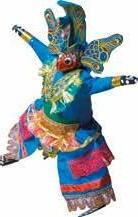
There are different departments in the shop: World Craft, Fair Trade Foods, Books and Magazines, World Music, and Household Goods. In the Fair Trade Foods department you can buy tea, dried fruit, organic forest honey and organic chocolate. The World Music department stocks a good range of CDs by musicians from around the world. The World Shop includes a bookshop with books on international subjects.
The World Shop is open Monday to Friday from 09.30 to 17.00. On Saturdays it is open from 10.00 t0 18.00. During July, August, November and December we are also open on Sundays.
If you buy Fair Trade goods, poor workers in developing countries will get a better price for their goods. They will earn more. And you will help to make the world a better place!
If you want to know when a shop is open, you can ask:When is the shop open? It is open from ... (day of the week) to... (day of the week) from ... o’clock to... o’clock. During ... (months) we arealso open on Sundays.
3. Talk to your classmate.
Work in pairs. Look at the pictures of shops and their opening times. Choose a shop. One of you asks: When is the shop open?
The other one answers: It is open from ... to ... from ... o’clock till ... o’clock, (and so on) Then try to guess which shop it is by asking: Is it the ... (greengrocer´s)?



You can guess twice, then swap roles.
open Monday to Friday from 9.00 till 6.00 o’clock. Saturday from 8.00 till 4.00 o’clock.
open Monday to Saturday from 8.30 till 6.00 o’clock. Sundays from 10 till 6.00 o’clock.
open Monday to Saturday from 7.30 till 4.30 o’clock. Sunday from 10 till 2.00 o’clock.



open Monday till Saturday from 9.00 till 9.00 o’clock. During July, August, November and December also open on Sunday from 10.00 till 5.00 o’clock.
open Monday to Saturday from 10.00 till 5.30 o’clock.
During November and December also open on Sunday from 10.00 till 5.00 o’clock.
open Monday to Saturday from 9.30 till 6.00 o’clock.
4. Watch the cartoon.
What do you think, what happened to the boy’s shopping list?
Tick an answer. Explain your answer.
O He has really lost it, because
O He has thrown it away, because forty-four
First choose a shop and a situation you want to act out.
Situation 1: buying clothes in a clothes shop. You can choose clothes from the advertisement.
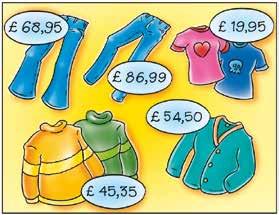
Situation 2: buying presents in a gift shop. Ask your teacher to give you the exercise.
Make a shopping list of the articles you are going to buy. shopping list
One of you is the shopkeeper and the other one is the customer. Find out what you need to do and say.
Shopping for clothes.
Shopkeeper: greets the customer and asks if he/she can help him/her.
Customer: asks for an article of clothing (or several articles of clothing).
Shopkeeper: asks what the customer would like and what size he/she would like.
Customer: tells the shopkeeper which size and which colour he/she would like.
Shopkeeper: asks the customer if he/she would like to try it on.
Customer: answers in a positive way.
Customer: tells the shopkeeper the clothes don’t fit and asks for another size.
Shopkeeper: gives the customer another size.
Customer: asks if he/she can return the articles and if he/she can get a refund.
Shopkeeper: tells the customer that the articles can be returned and that you can get a refund within eight days.
Customer: pays.
Shopkeeper: thanks the customer and says goodbye.
Customer: says goodbye.
7. Act it out.
Act out your conversation.
Finished? Do this.
Read the sentences. What is it?
Write it down.
1. It fits in your pocket and you often use it when you go to the shops. It’s a
2. It is very long, people sometimes push when they´re in it. It’s a
3. It is made of glass. When you look at it, there are goods behind it. It’s a
4. It has wheels and you have to bring it back to the shop. It’s a
5. In this place there are knives and vegetarians don’t like what they sell. It’s a
6. You must not lose it if you want to return an article. It’s a
7. One of the jobs of a postman is bringing a to the right address.
8. In this place you can find things to write with, to write in and to write on. It’s a
Finished? Test yourself.
Solve the supermarket puzzle. Your teacher will give it to you.
Nice to know
Portobello Road. Portobello Road in West London is the world’s largest antiques market. It is open every Saturday. There’s also a range of normal and specialist shops. In the galleries and arcades you can see a wide variety of antiques, dating from Roman times to the 1960s. Lots of antique dealers have stalls there.
Asking how much an article costs: How much is it? It is ...
Asking how much two or more articles cost: How much are they? They are
When you talk about something that is near, you say : this ... (pencil, book, ...) When you talk about things that are near, you say: these ... (pencils, books, ...)
A shop assistant may ask you: Can I help you?
If you would like to have a look at something, you can ask: Could I see that ... (T-shirt) / those … (jeans), please?
If you would like to know the price, you can ask: How much does it cost? It costs ... How much do they cost? They cost ...
If you have bought an article, you can ask: Can I return the article? Can I get a refund?
If you want to know when a shop is open, you can ask: When is the shop open? It is open from ... (day of the week) to ... (day of the week) from ... o’clock till ... o’clock.
During ... (months) we are also open on Sunday.
Words to know
almost bijna article artikel bargain koopje butcher’s slagerswinkel
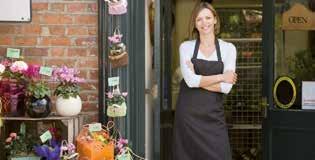
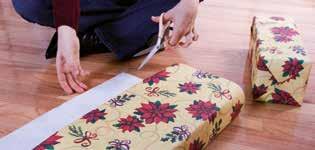

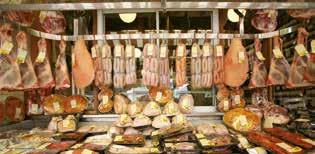
careful voorzichtig chemist’s apotheek/ drogisterij clothes shop kledingzaak customer klant dairy zuivelhandel discount korting expensive duur for example bijvoorbeeld free gratis large/medium/ groot/midden/ small klein parcel pakketje probably waarschijnlijk queue rij receipt kassabon shop assistant winkelbediende shopkeeper winkeleigenaar
shopping centre winkelcentrum shop window etalage size maat special offer aanbieding stationer’s kantoor boekhandel to carry dragen to fit passen to forget vergeten to get a refund geld terugkrijgen to order bestellen to pay by credit card met een credit kaart betalen to pay cash contant betalen to return terugbrengen (van goederen) to sell verkopen to show tonen, laten zien to spend besteden/ uitgeven aan to try on aanpassen to wrap up inpakken toy shop speelgoedwinkel wallet portemonnee
